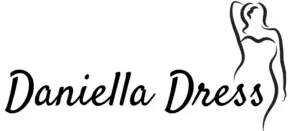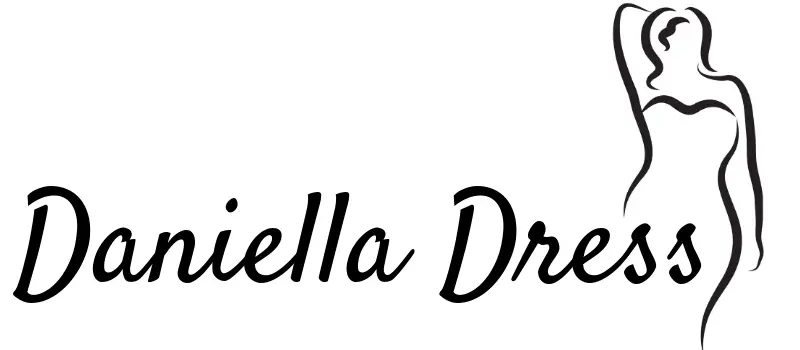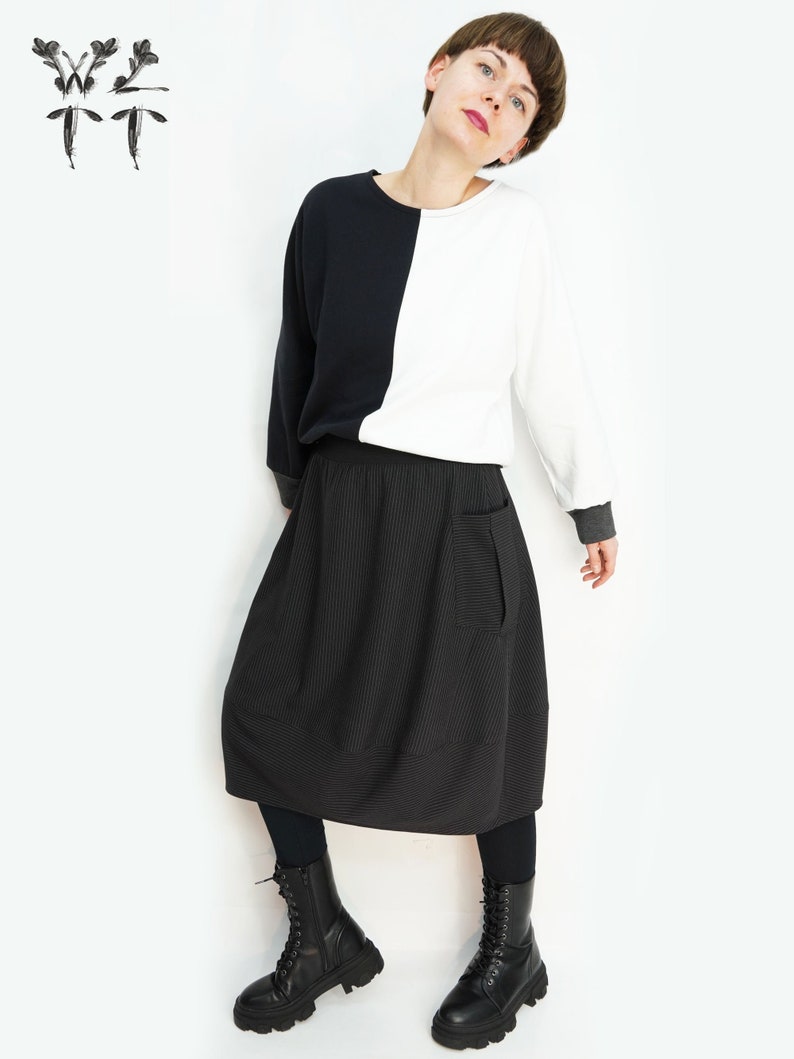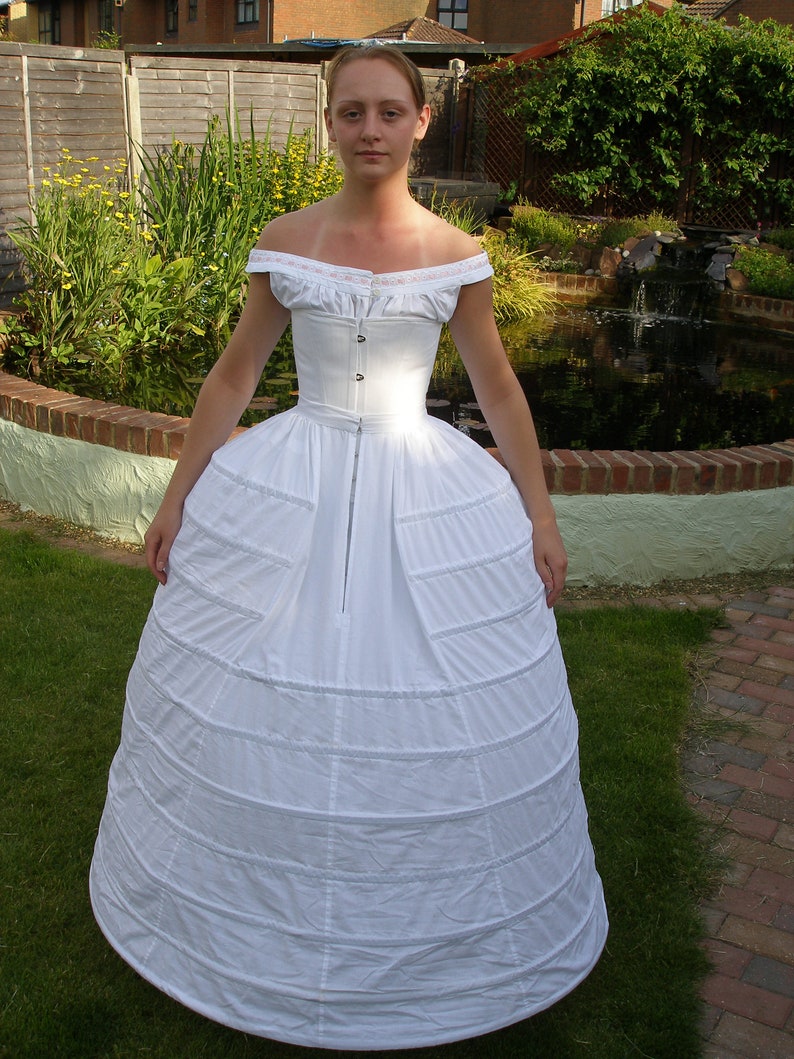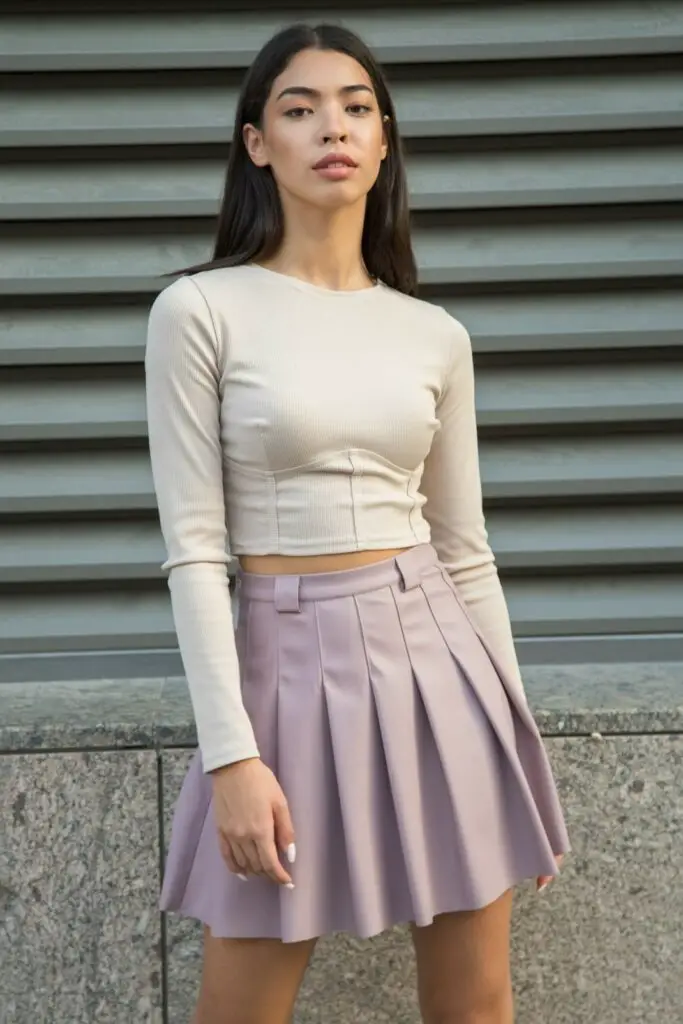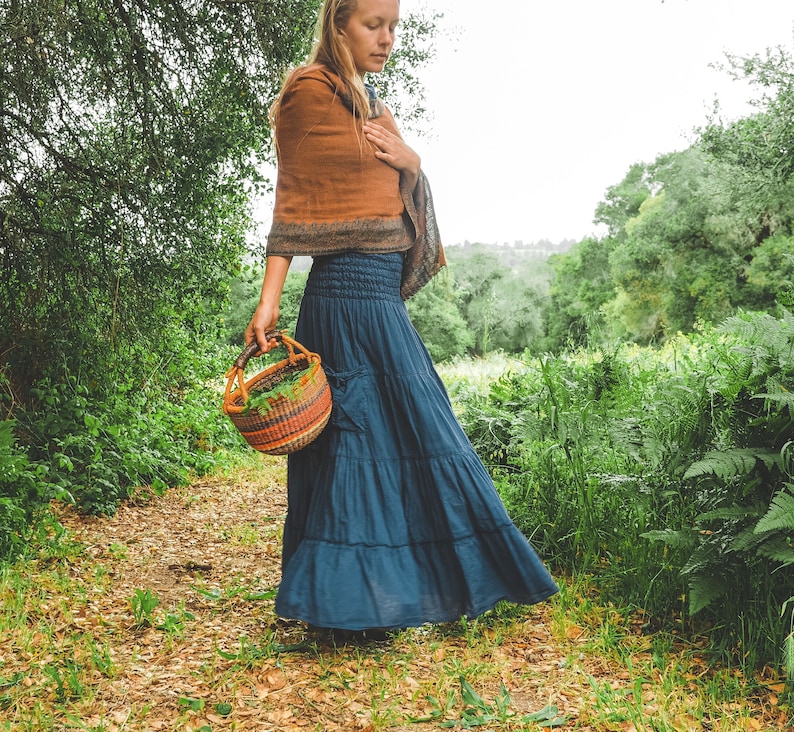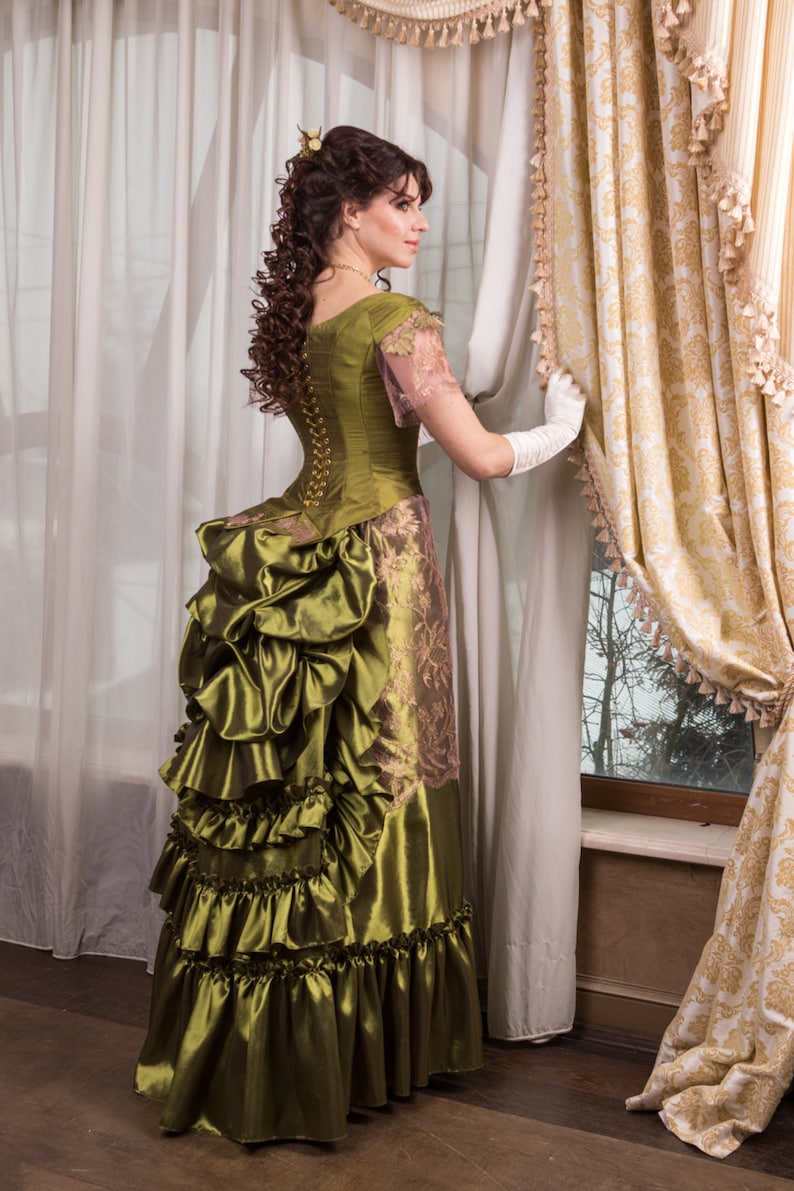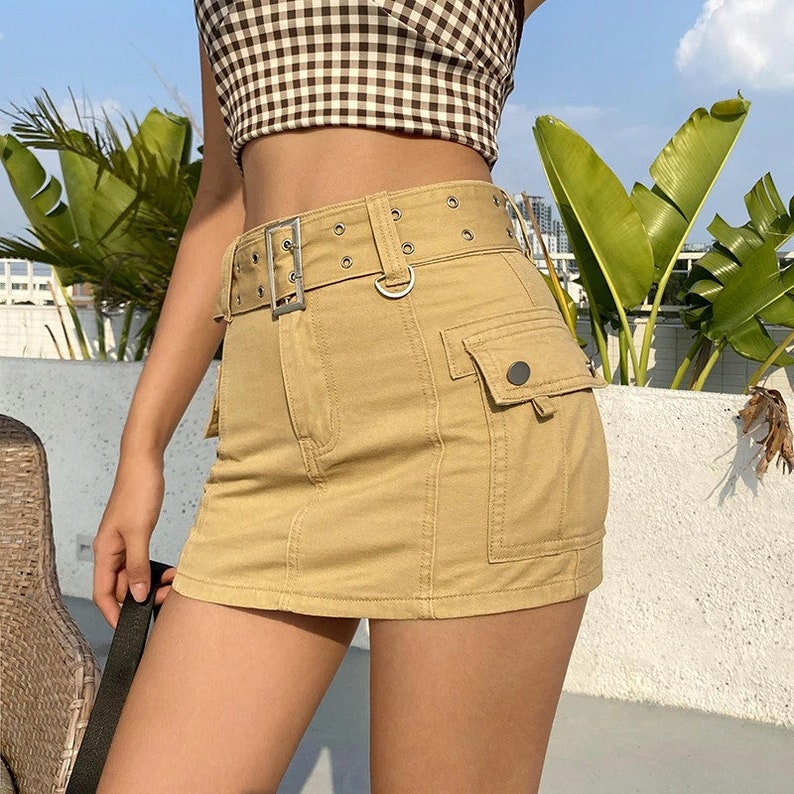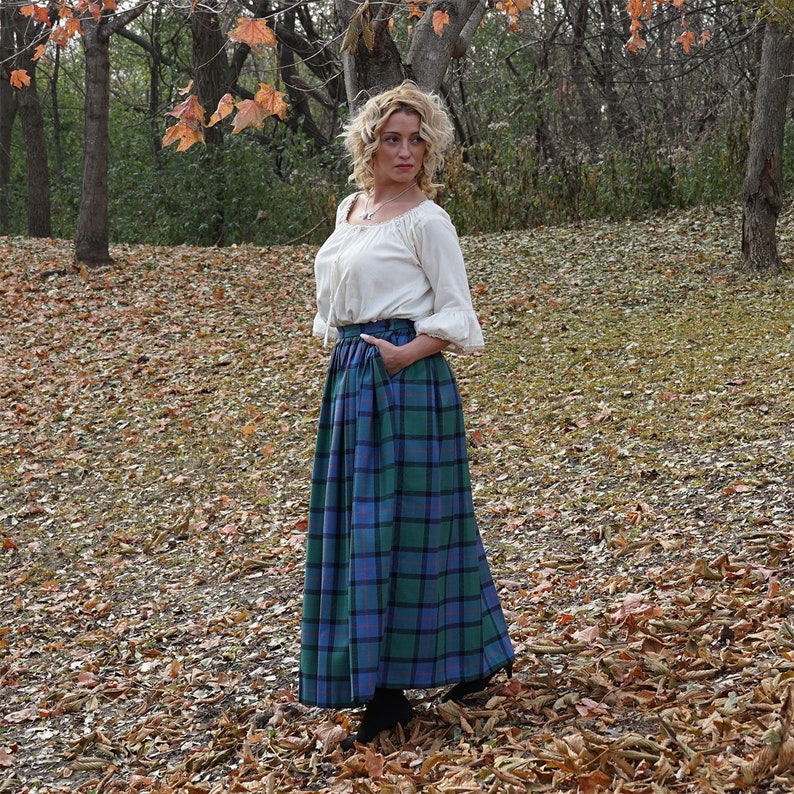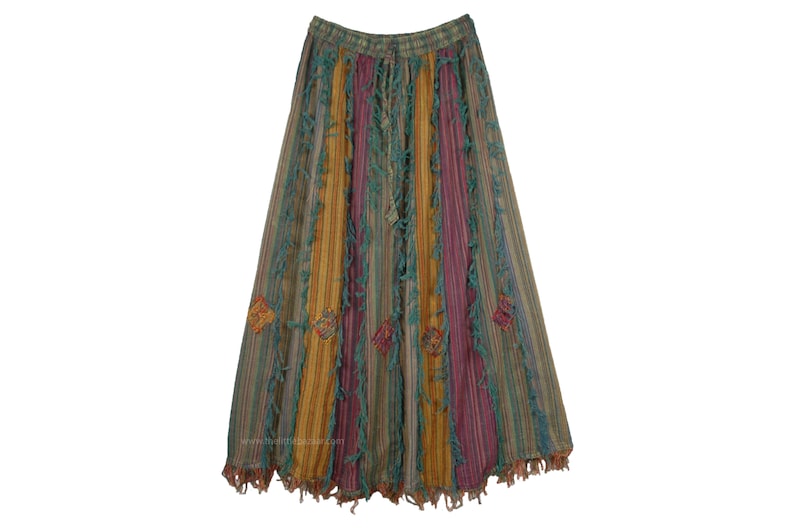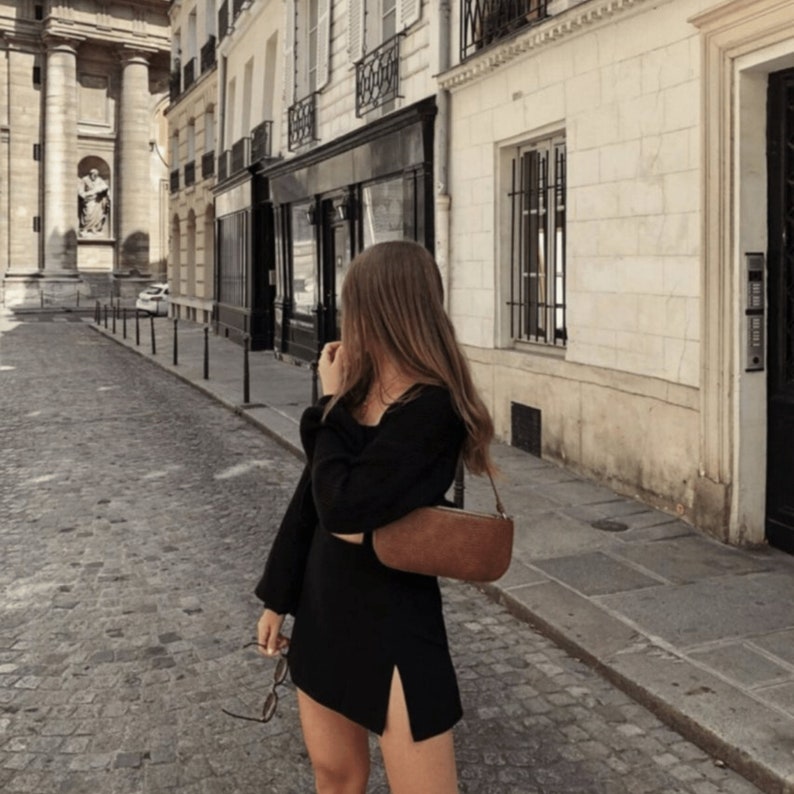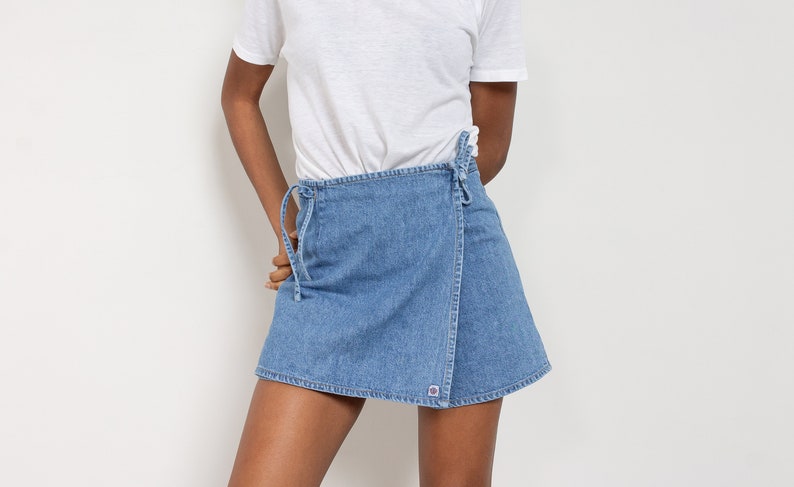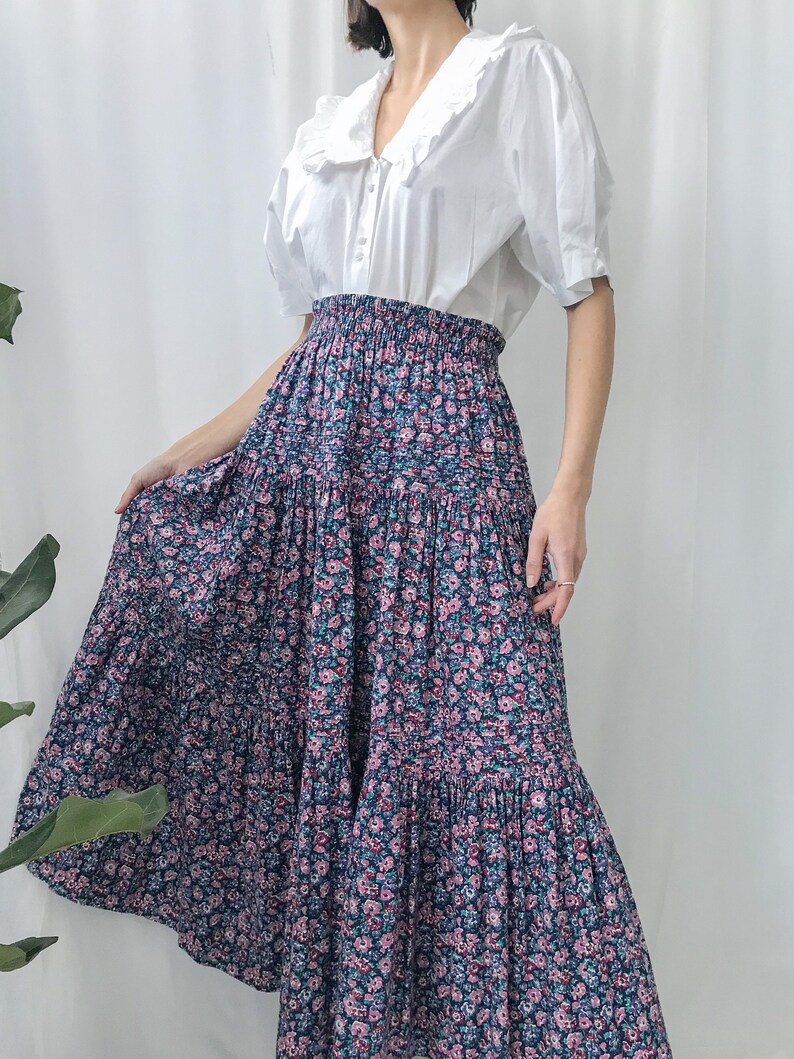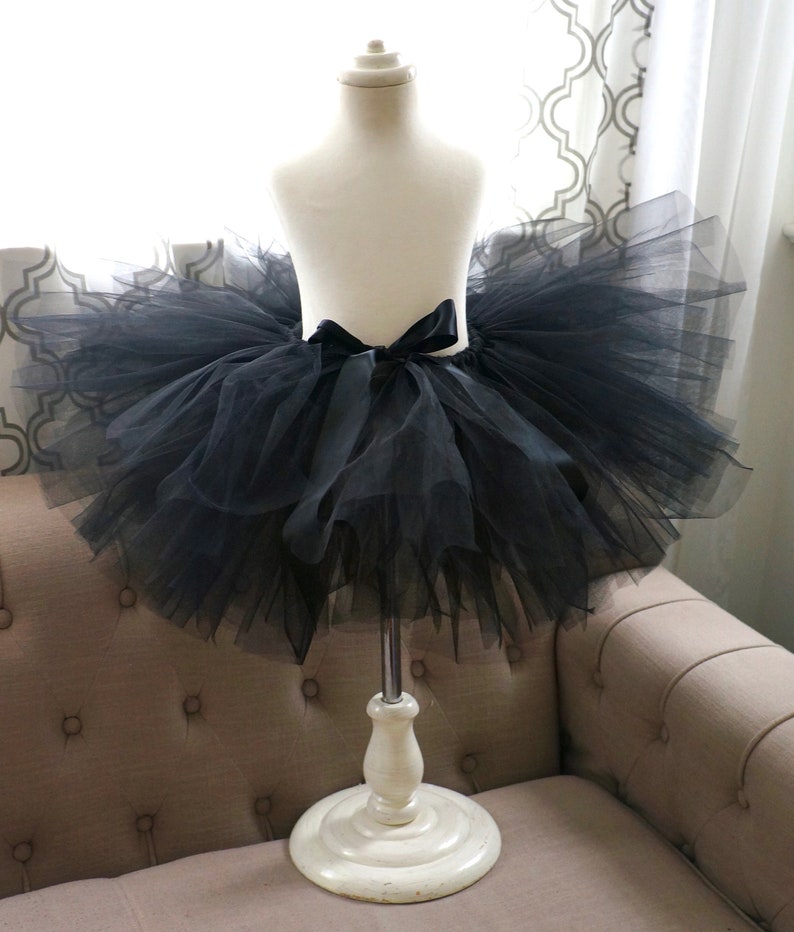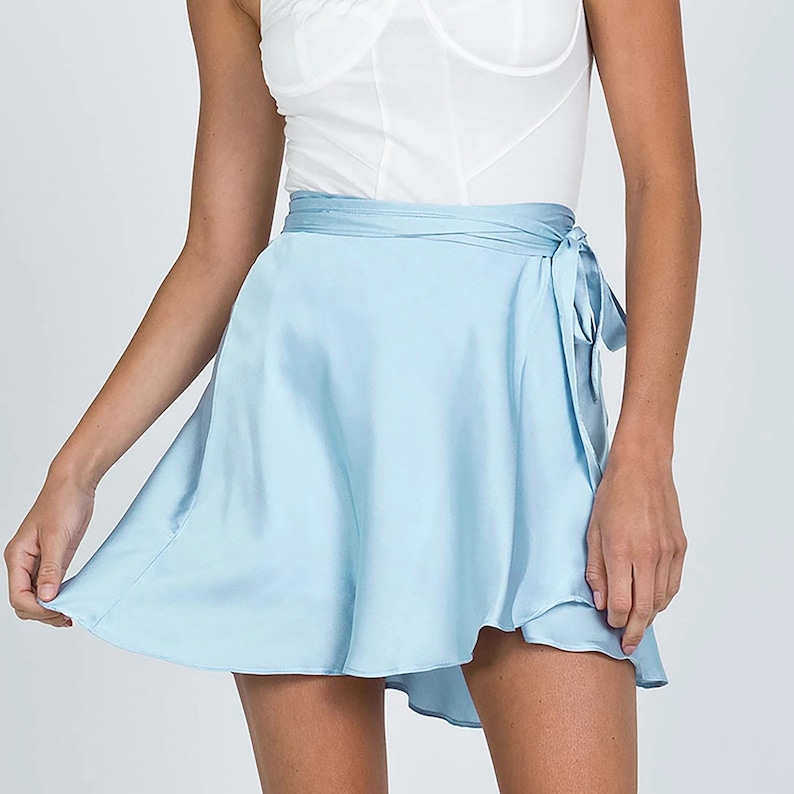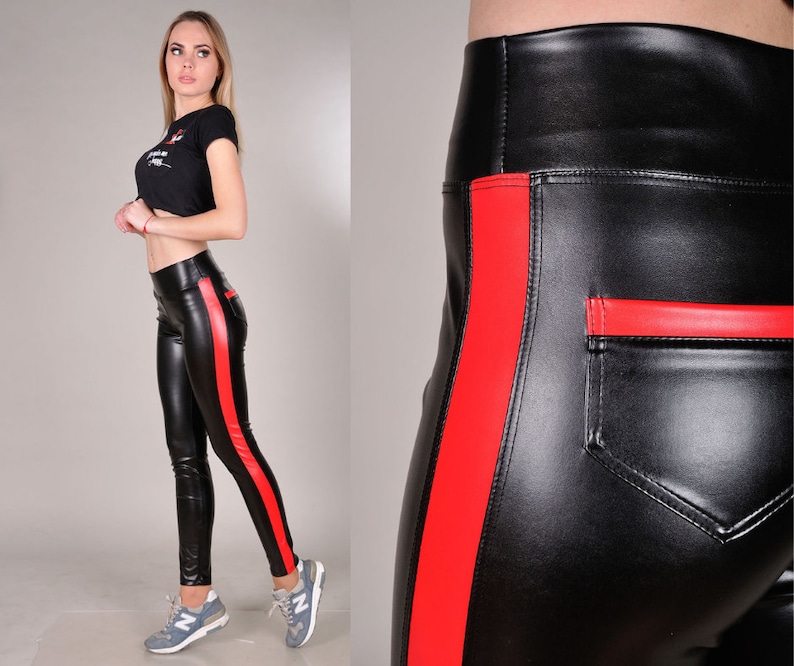The skirt has been around since ancient times. Different historical proofs show us that women's skirts are actually older than men's pants in the history of fashion. Consider imagining images of past civilizations. Wearing skirts was a common feature of Roman soldiers. Greeks wore long dresses known as togas, which cover everything. Aztecs typically wore skirts, and loincloths were a variant of them. Even the Egyptian women wore miniskirts, as well as the men. Trousers have only been widely accepted since fairly recently in human history. When the Romans first invaded Britain, they were surprised to learn that the people there wrapped their legs in cloth.
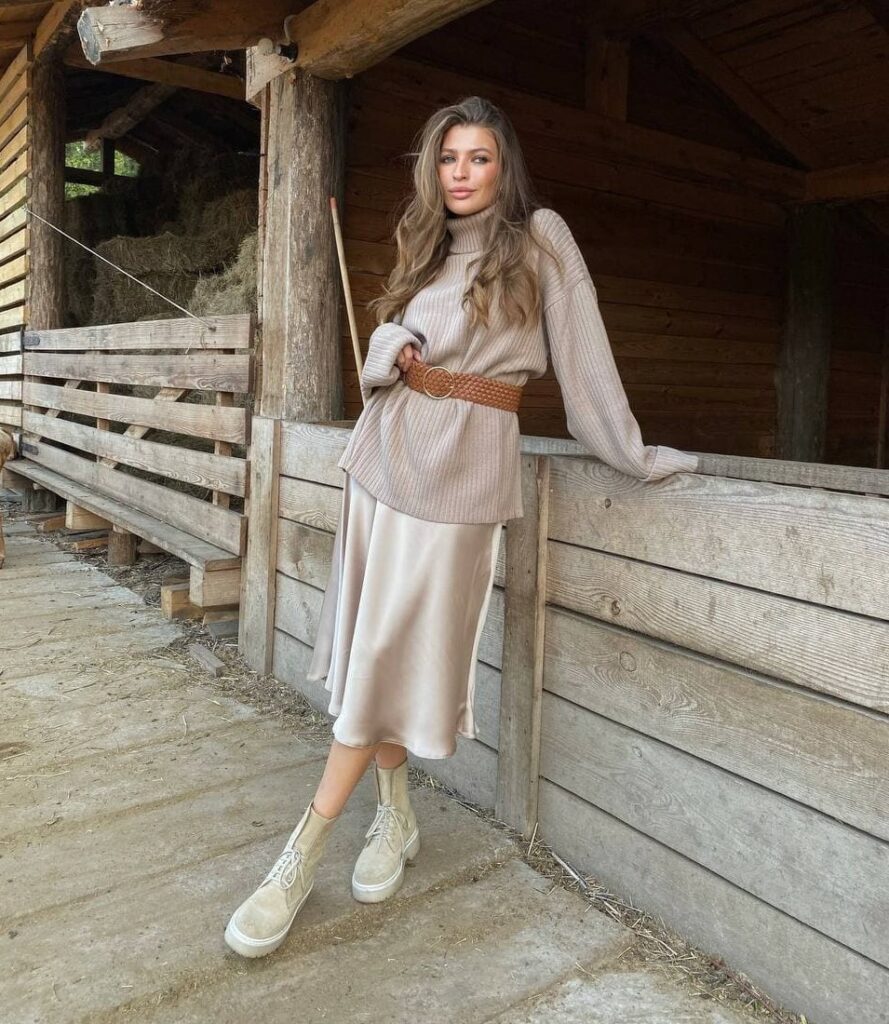
Thus, it makes sense that the first fashion ever created was skirts. Since it is much easier to wrap something around your waist than to shape and cut leather, it is always more convenient to wear something wrapped around your waist than to cut and shape fabrics to be worn around your legs.
Men and Pants
Clothing for men did not become popular until the 1300s in Europe. Making pants was made much easier as a result of improvements in tailoring. Even then, men and women wore skirts and pants for hundreds of years. Until the 1800s, skirts were thought of as things only worn by women.
Women and Skirts
For many centuries, women have worn skirts to send certain messages to society. Significance went hand in hand with length and multiple layers of skirts. Cloth is expensive after all. Finally, women started wearing skirts in order to claim their own identities. In addition to meaning, skirts can also convey status and power, making them one of the oldest garments ever created. Because there are so many different types of skirts to choose from, that might be why!
Types of Skirts
There have been many changes in skirt styles throughout history, all of which have occurred in response to distinct fashion trends. There are some types of skirts that remain in style forever, while others had a limited life span. Which skirt styles can you identify?
A-line
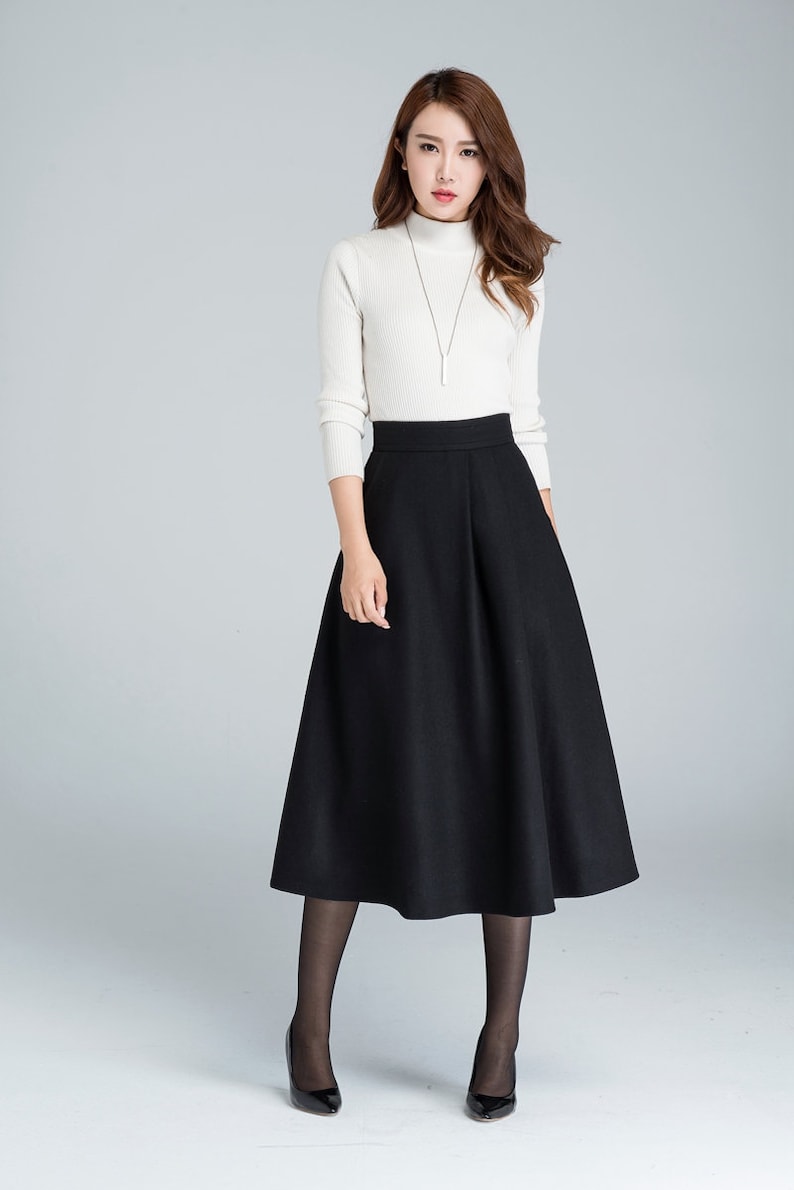
Selecting an A-line skirt will afford versatility. When skirts come to a point at the hem, the lining skirt is designed to flatter a figure by being fitted at the waist and hips and then flaring out. This design accommodates free flow and movement while looking good for work or as a fashion statement for a night out. A-line skirt is called that way because the line drawing resembles the letter A.
The A-line, a design for mid-calf lengths, was first created in the 1950s. Christian Dior was responsible for this. Dior skirts were a hit among women who preferred simple, elegant lines. As millions of women read about Jackie Kennedy in a skirt that was an A-line, many of them purchased their own.
Asymmetrical

More modern and current asymmetrical skirt styles look stylish, and they're a huge trend right now. These days, all the hot celebrities are breaking with tradition by sporting asymmetrical hemlines. In fact, asymmetrical skirt styles have been quite popular in the past. They've been around for 150 years, so they are well established.
Ladies from the Victorian era, it's been argued, were radical. Skirt styles in the 1870s and the 1880s, 1920s, and 1930s all exhibited asymmetrical fishtail-style hemlines.
Despite the fact that the asymmetrical skirt is simply as historic as the hoop skirt, it is still very popular. Remembering fashion history is something to keep in mind when you wear an asymmetrical skirt.
Balloon
Scenic types of skirts may easily be mistaken for those that aren't an expert. In the case of the balloon skirt, this is not the case. You're not going to confuse this distinct shape with anything else. It is appropriate for the waist on the balloon skirt. The skirt is gathered up at the hem to create an even fuller silhouette. If you ever wanted to feel like a princess, then a poofy balloon skirt is perfect for making any girl feel glamorous.
Balloon skirts can be short or long, and they can be decorated in any way. Some of the dress shirts are pleated while others are asymmetrical. Balloon skirts frequently incorporate multiple skirt styles into a single visually striking ensemble.
Bell
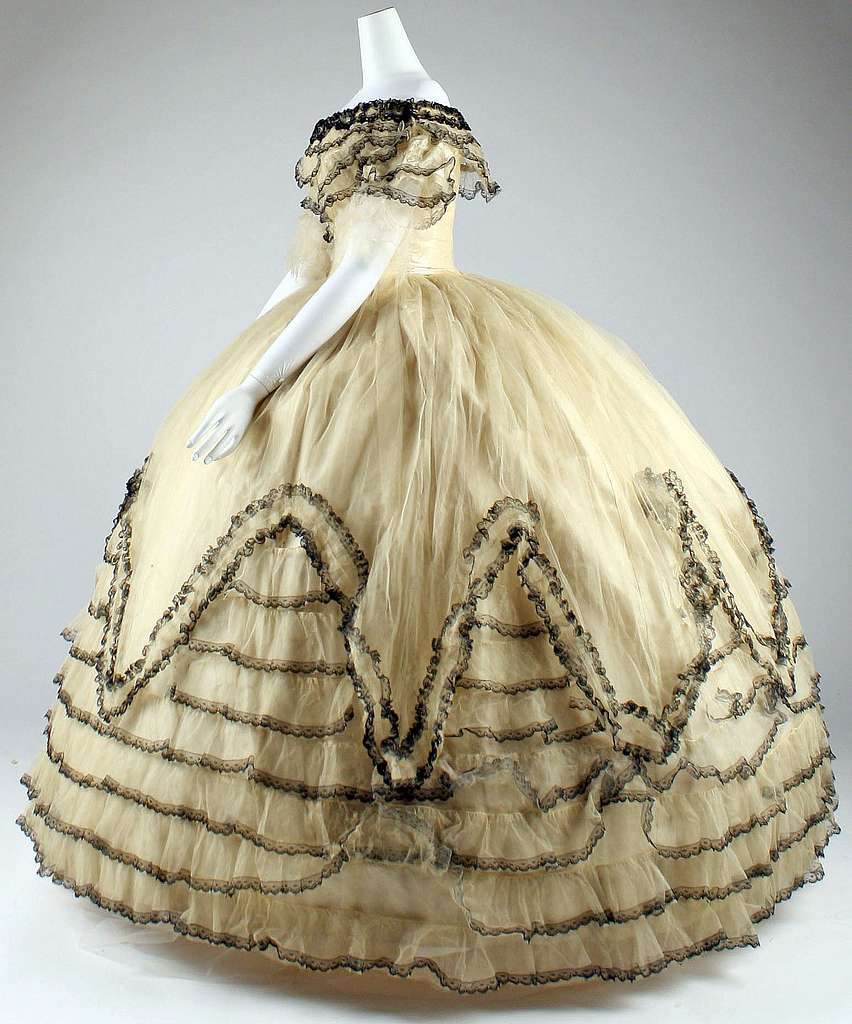
One of the most distinct looks of the mid-1800s was the bell skirt, which is also known as the crinoline. The practicality of this huge skirt from “Gone With the Wind” is akin to Scarlett O'Hara's on-screen co-star from the film, and it is in actuality a potential fire hazard. It is unlikely that the enormous bell skirt will ever be in fashion again.
For some time, women had been wearing big, billowy skirts. Then in the 1840s, the bell-skirted look became popular. However, for some strange reason, it was this decade that caused skirts to grow to increasingly larger sizes until they reached the state of gigantic bell skirts that no one can find anything remotely flattering about. To achieve the enormous bell shape, women had to wear several layers of petticoats. Each petticoat could weigh anywhere from 14 to 17 pounds.
Everything fundamentally changed in 1856. The cage crinoline was created at this time. A simple petticoat of steel wire was what she had created. This could provide women with a huge amount of volume but without all of the weight in the petticoat. This is the piece of equipment you see women wearing in all of the Civil War-era movies, and this is the way the 1800s dress generally looks. Another name for the bell skirt is the hoop skirt and this is why… Before electricity was used, these skirts were made of highly flammable fabrics. The crinoline had a rigid structure that literally led to the deaths of thousands of people in its day. During the heyday of crinolines alone in the 1850s and 1860s, over these two decades, approximately 3,000 women in England alone died from skirt fires. Bulky skirts made women clumsy, often touched candles, and did not allow people to quickly leave a building that was suddenly on fire. Some women simply caught fire by standing too close to the fireplace, while others died in a massive crush. In 1864, it was estimated that since 1850, nearly 40,000 women worldwide have died due to crinoline-related fires.
Style
Bell skirts have fallen out of favor, due to their impractical size. Women's skirts had grown so large that they had trouble maneuvering doorways and even intimate gatherings grew cramped, even with just a few guests present. The enormous bell-skirted dress made sitting virtually impossible, and crawling into and out of a carriage was difficult, to say the least. Fashion slimmed down in the late 1800s, and skirts became a great deal more manageable by that time. The bell skirt made a brief moment of fashion, but we shouldn't expect it to return.
The flared skirts with the bell-shaped design usually have bell-shaped skirts that flare both ends. Because the skirt has been layered and is, therefore, more elegant, the flare on the opposite side of the skirt appears to mimic the effect of layering. Whether the bell skirt is made with a solid color, print, or plaid, the skirt looks more formal.
Box Pleat
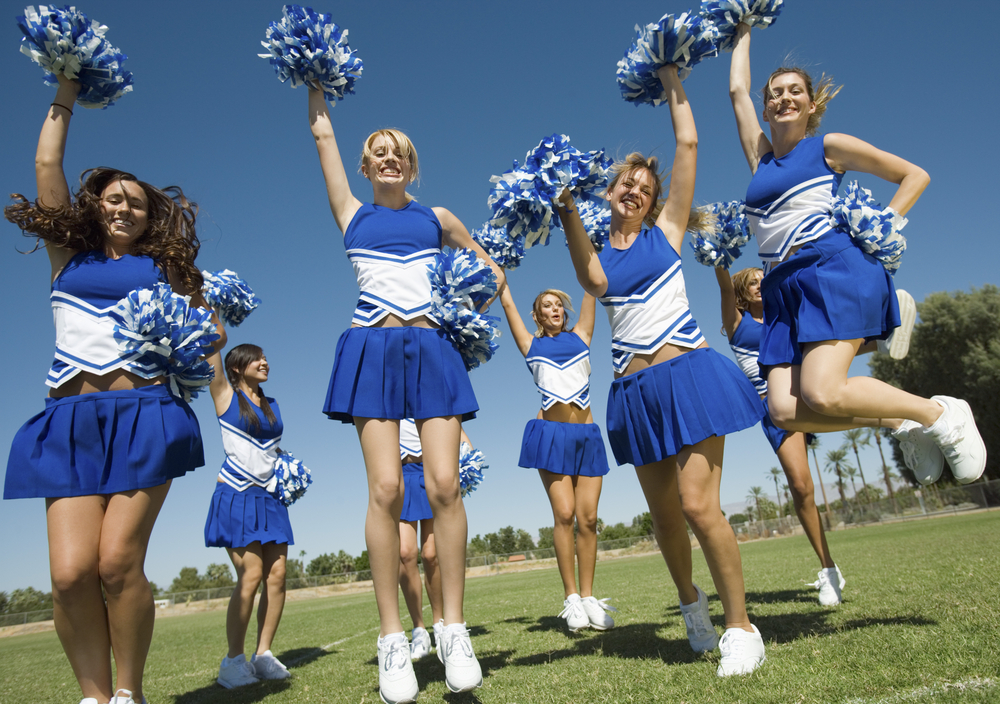
This pleated skirt is perfect for those who want to look young and fashionable. Box pleat skirt makes it a great choice for cheerleaders, tennis girls (the skirt comes with inside shorts), and dancers to wear on. A prominent type of pleat that differentiates styles is box pleats. Knowing how to identify a box pleat will allow you to spot this style feature consistently.
Two pleats are folded toward each other to form a box pleat. While standard pleated skirts are constructed with pleats that all point in the same direction, this skirt is made in such a way that pleats point in a different direction. To define a box pleat skirt, you can add only a few box pleats. The rare density of box pleats will make you look in a fun, flared-out youthful way.
Boucle
A boucle skirt is a skirt made from bouclé fabric. Boucle is a fabric with a distinctive texture. The fabrication, made from a specific type of ringed wool yarn, has become synonymous with high-end fashion. The boucle fabric is knitted or woven. It has a distinctive “pebbly” or “hairy” surface, which is a result of textured yarns or fibers being twisted together. The yarns or fibers may be twisted or twirled in the same direction, or in the opposite direction. The type and direction of the twist decide the character of the wool. The direction of twist is the key to the many different boucle fabrics, from the heavy, bulky boucle to the light, soft boucle. And though it has been used for centuries to create clothing and furniture — arguably Coco Chanel who first made it fashionable.
Broomstick
There is something very familiar and classic about the broomstick skirt's look. A long time ago, if someone said, “Did you see anyone wearing a broomstick skirt?” you probably wouldn't have even known what they were talking about, however, you definitely saw it.
While other designs present straight pleats, the wrinkled appearance of these pleats is what sets this design apart. They are pleats that are neither long nor straight. It's correct to say that rather, they have a wrinkled appearance. To obtain this effect, the steps must be performed in a particular order. That is correct, and it is relative to a broomstick. Wetting the material thoroughly, and then rolling it up around a broomstick, causes the creases in this skirt. Once the skirt is unwrapped from the broomstick, it possesses the particular aesthetic that is characteristic of the broomstick skirt.

Broomstick skirts are typically created to be both comfortable and fashionable. Most standard lengths are long down to the ankles. The elastic waistband is made for greater comfort and flexibility. It gives off a laid-back, comfortable, and homey look. A broomstick skirt is the ideal item of clothing to wear while relaxing in the park, going to the movies, or for other similar purposes.
Bubble
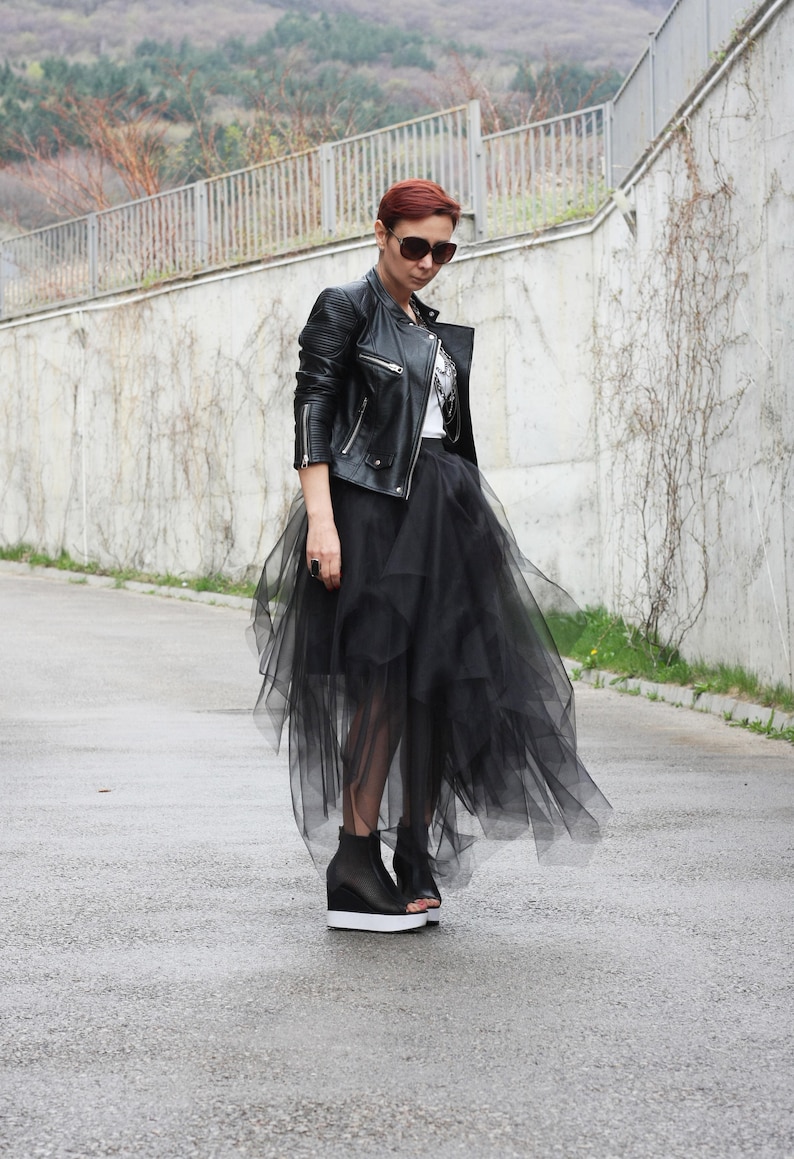
Bubble skirts are a perfect way to add some pep into your step and show off your style. These skirts are made of a flexible, lightweight material that moves with you and will surely have heads turning as you walk by.
The bubble dress is a recognizable silhouette. The bubble shirt is a full-length, gathered skirt that forms a defined silhouette by bunching up the skirt's upper half. This skirt has a 1980s style, but its design appeared after World War II. This is a skirt from the 1950s. Many designers created bubble-skirted cocktail dresses during the 1990s as a very in-vogue style. These glamor girls all wore bubble skirts evening gowns.
Bubble skirts made a comeback in the 1980s, and they've reappeared in recent years. Bubble skirts have become more popular on runways recently, indicating that this style will always be in style. Because of their shape, these skirts are known as puffball or harem skirts.
Bustle
The 2nd most uncomfortable of the listed options after the bell skirt is the bustle skirt or bustled skirt, the hardest to get used to.
A bustle skirt can be spotted at first glance. This skirt was gathered at the lower back, a position which is slightly lower than the small of the back. Instead of having the skirt skim over the rear end, the skirt's fabric was gathered all the way back to cover the lady's butt entirely. The general impression left after looking at the sight was that it had created a distinct shape that's always on display in movies set during the late 1800s.
To illustrate the strange skirt silhouette, the bustle in the back of the dress was truly enormous. Bustled skirts limited the wearer's sitting posture, which goes without saying. While it may sound silly, this style is alive and well. Although bustle skirts are used occasionally in wedding gowns, this extra back fabric helps the dress billow out and gives it a more dramatic shape.
Button Up
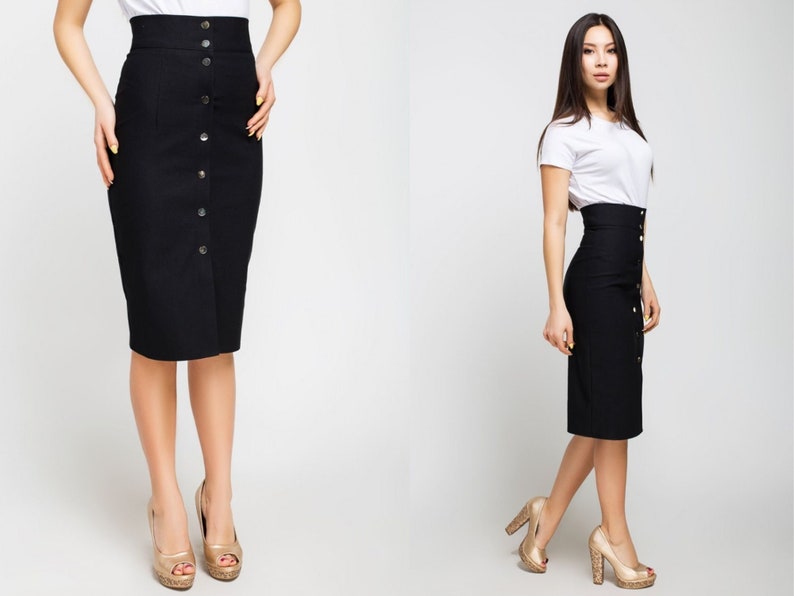
What's a button-up skirt? It is a skirt that has a button closure from the top to the bottom, making it easy to wear as well as more comfortable. Buttons can be on the front or the side of the skirt. This skirt is perfect for casual days and with some loafers, can be worn during the day too. Different fabrics can be used to make skirts. Jeans, however, are most commonly found to be constructed from this material.
Any of these name variations button-down, button front, snap front, or simply button skirt imply a button-up skirt or snap button skirt. They can be made in a range of lengths, including mini, midi, and maxi skirts. Functional buttons, snaps, or merely decorative can be used.
Cargo
Cargo pants that were a source of inspiration for this outfit have cargo pockets, like cargo pants that already exist. Cargo skirts instantly differentiate themselves from other types of skirts due to their large patch pockets. The most typical cargo skirt is a tough, easy-to-wash outfit that is worn by the majority of the general population.
Circle
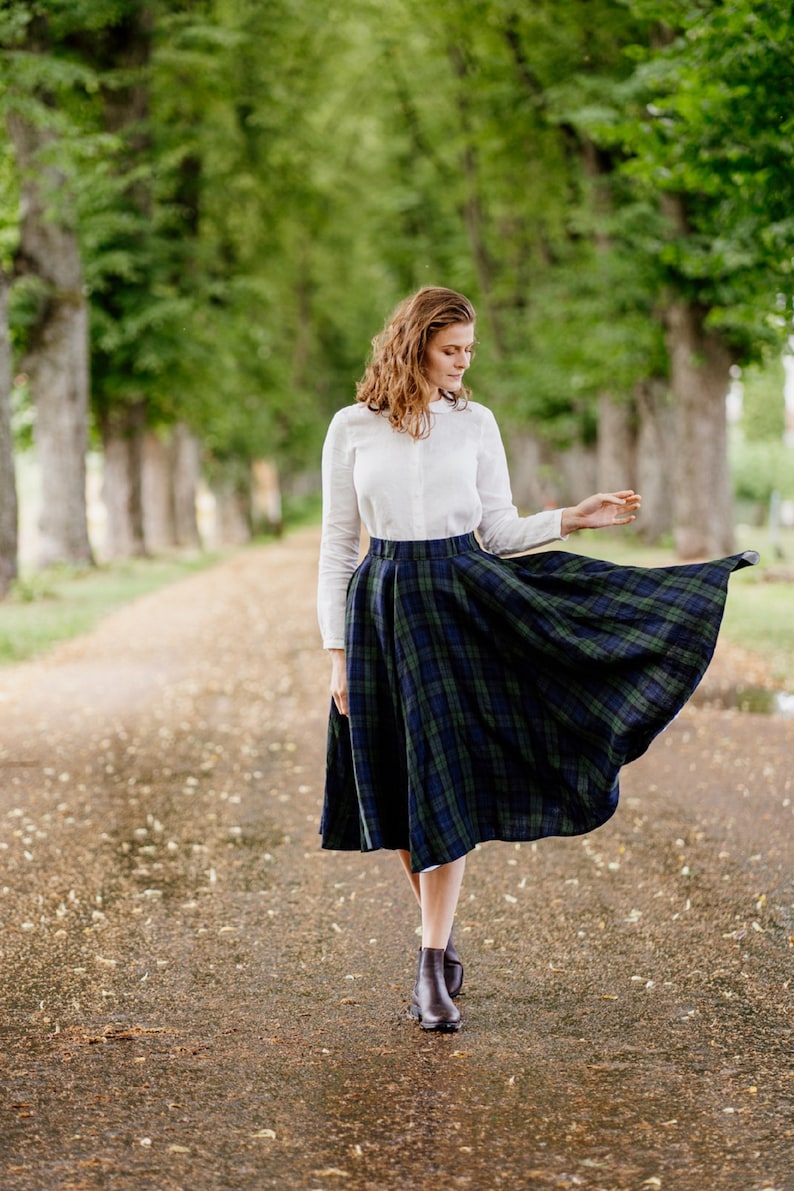
Prior to the circle skirt becoming recognizable in the early 1900s, however, this skirt gained popularity in the 1950s. It is among the most simple skirts to sew and one of the easiest to make if you have the DIY spirit. A single piece of fabric is cut into a large circle and is used to make the circle skirt. At the very center of the design, a smaller circle is cut out. For the waist, this is. A few buttons or a zipper are all that's needed to put a full circle skirt together. To make a half-circle skirt half a piece of full circle skirt fabric used is required, its style is very popular in girl's and women's fashion. Even fewer fabrics are needed for a quarter circle skirt.
Stylish design traits from the 1950s include skirts that hit just below the knee, which can be worn with slips to increase the skirt's volume. The circle skirt is flared as a result of how it's made. Also known as a swing skirt, a circle skirt is perfect for casual occasions. You could wear a T-shirt with your favorite sneakers. The nice thing about this outfit is that it will also look dressy if you change your t-shirt or sweater into a blouse. A circle skirt would work well for more formal events like weddings or dinner parties. With its beautiful lace detail and flowing fabric, it will make any dress into the perfect evening gown.
A skating skirt is created when a circle skirt is cut above the knee. Ice skating costumes from the 1980s inspired the design of the skater skirt. This skirt is short and flared, with a waist that is high. With its prevalence in the '80s, you will still see this '80s-era trend everywhere today. A good chance is that you have a skating skirt in your closet already.
Cowl

The gathered-at-the-hips skirt's cowl design creates a cowl neckline. The rest of the cowl skirt begins to narrow to fit closely around the legs below the gathered section above each hip. Cowl skirts can correct the woman's figure, visually enlarge the hips.
Dirndl
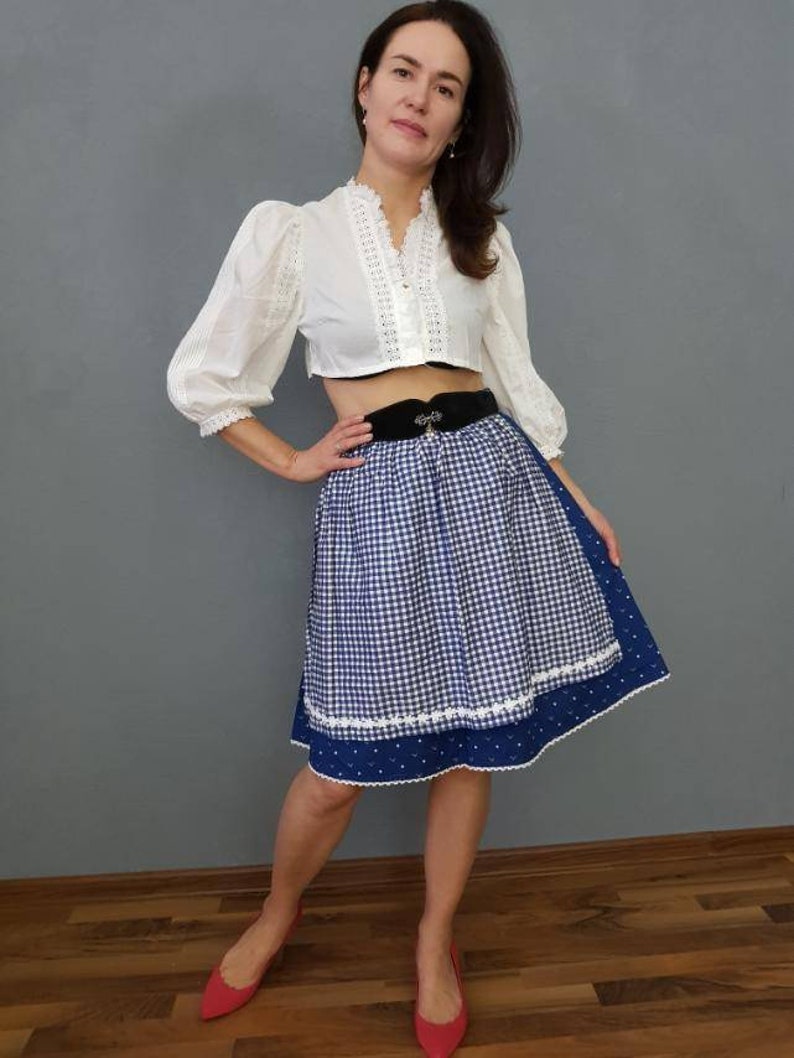
A dirndl skirt was popular in the 1950s when the simpler styles in skirts were very popular. It came from Austria, a traditional skirt is full, has a knee-length and could be longer. Traditional dirndl skirts were popular in the Alps region, in the 1800s. They have a front short apron, and straps for the shoulders, however, these days dirndls typically do not have these features.
A knot tied at the waistband of the traditional dirndl skirt also sends a message regarding a woman's marital status. If a girl is single, she would put it on the front left-sided. The only place that a married woman's knot could be worn was on the right side of the waistband. The widows tied the knot at the waistband's back.
Draped
A draped skirt can be characterized as a skirt in which the fullness of the fabric is draped around the body. The skirt may be any length, and it can be done in a symmetrical or asymmetrical style. The draped skirt has been one of the most popular skirt styles for thousands of years, dating to the ancient civilizations of Greece and other early cultures. A large number of modern designers have toyed with the draped appearance, forming clear ray-like folds on clothes. The variation of the draped skirt in a cowl skirt.
Flared
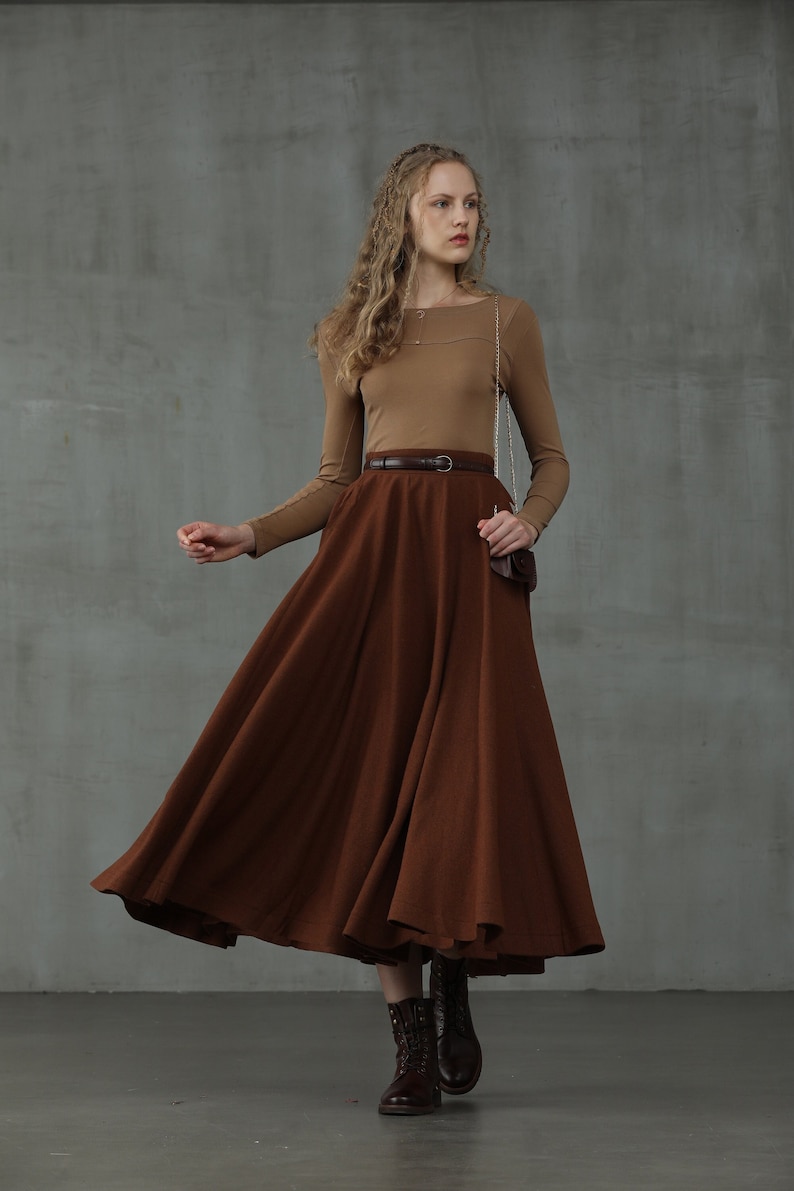
Although there are multiple types of flared skirts, they can all be placed into one category based on their outward flare and a lot of volumes. In contrast to skirts like the pencil skirt, which is very form-fitting and hugs the legs, skirts like this are looser and flowier. For a flared skirt, a waistline will flare out from the hips. You can have a short or long flare skirt, depending on your preference. The difference between flared and circle skirts is that the circular skirt is wide from the waist, and the flare is narrow from the waist to mid-thigh and expands through trapezoidal wedges.
Gathered or Full
A full gathered skirt is a skirt that has a lot of fabric gathered at the waist. The width of the skirt will affect how much fabric gathers around the waist. Thicker fabrics will require more gathering in order to create this style. A full gathered skirt will also give you a retro or vintage look. Many people wear this type of skirt for a boho look, but this particular style is so versatile that you can wear it in any style. A dirndl, prairie, and a bell skirt all are types of a gathered skirts. What's more appealing than a gorgeous full gathered skirt? It has a lot of volumes, and we love that about it.
Godet pleat

This godet pleat skirt is commonly found in cheerleader outfits. For those who like a lot of color in their outfits, this design is ideal. Triangular pieces of fabric are inserted into the pleats at the bottom of the skirt to create a godet pleat. A contrasting or complementary color is used for the added fabric of the skirt. The skirt design that results is a two-color flared skirt.
The most common length of Godet pleat skirts is for skirt styles that are below the knee.
Gored
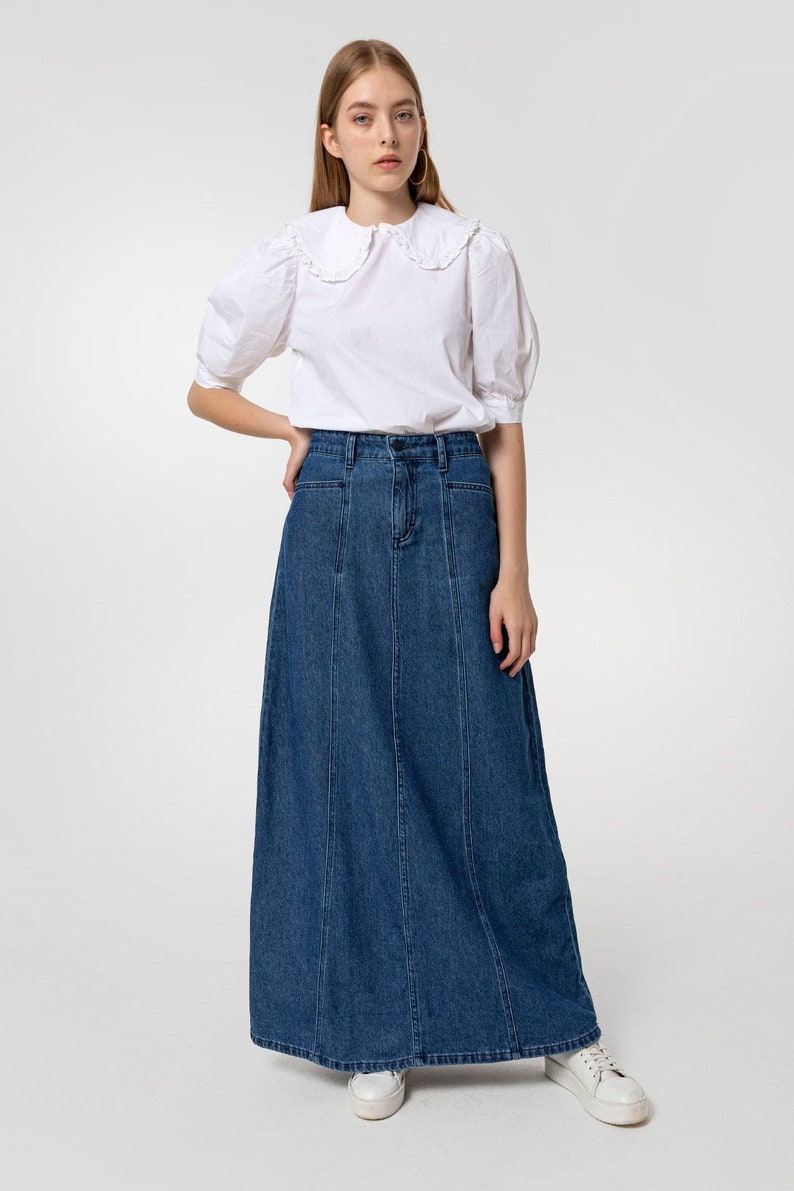
In this case, “gored skirt” is something that is unique because of its distinctive design. In a gored skirt design, triangular pieces of fabric are sewn together to form a three-dimensional pattern. The waist of the triangles consists of the points of the triangles, and the width of the triangles increases as they go down through the skirt until the base of the triangle becomes the skirt's bottom.
Godet pleated skirts are made using triangular pieces of fabric, just like the construction of the gored skirt. Even so, the triangles stretch the full length of the skirt in the gored skirt design. Godets skirt features two vertical strips of fabric placed along the skirts' lower portion.
Gypsy
It is fun and colorful, making it an enjoyable DIY project to create a gypsy skirt. It gives this skirt a lot of its charm because of the homemade look. A long, full skirt is made with a lot of fabric in a wide, flared style and has a waistband called a gypsy skirt.
Gypsy skirts feature a tiered design, making them very distinct. Each band of fabric is larger in circumference than the one below it. The flared design is a result of this. All sorts of different looks can be created by using the same fabric or different fabrics of varying colors.
Handkerchief
The handkerchief skirt is constructed of multiple square pieces of fabric that are sewn together to give the skirt a zigzag hem. This layered skirt should fall at least to the knee and could be longer. The handkerchief skirt can be seen as an asymmetrical flaring skirt that takes on an unexpected new dimension with an uneven hem. Discreet colors and texture of the fabric will preserve the business, office style. It can be worn both casually and formally with a wide variety of tops.
High Low Skirt
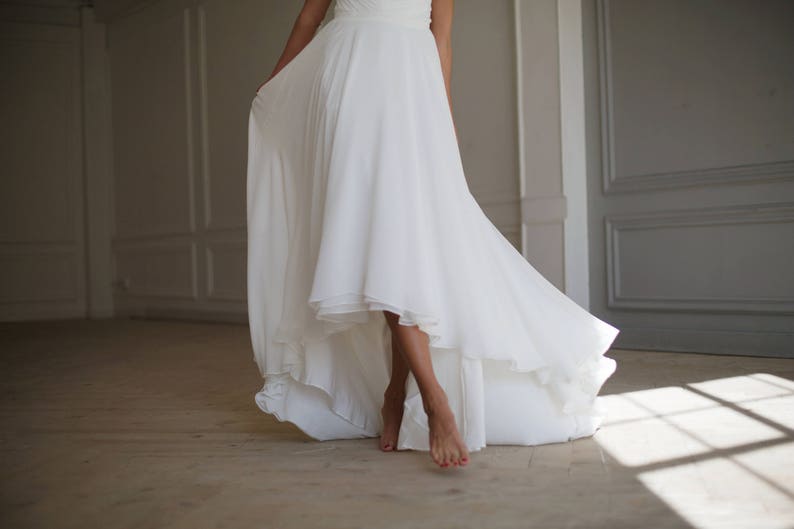
A high-low skirt is a skirt that is long at the back and short at the front. It usually has an A-line or inverted triangle shape. This skirt is perfect for women who like to show off their legs. Also called a mullet skirt is quite a bizarre name for a skirt type. It is named after the hairstyle of the same name, which is where the skirt gets its name from. A high low skirt is a bit controversial and you will find some people love it and some people hate it. It is also great for women with shorter torsos. A high-low skirt can be a great addition to your wardrobe. It is a versatile piece of clothing that can be a part of a variety of different looks. The high-low skirt looks best on women who have a lean body type. The waistband should be a few inches below your natural waist.
High Waist
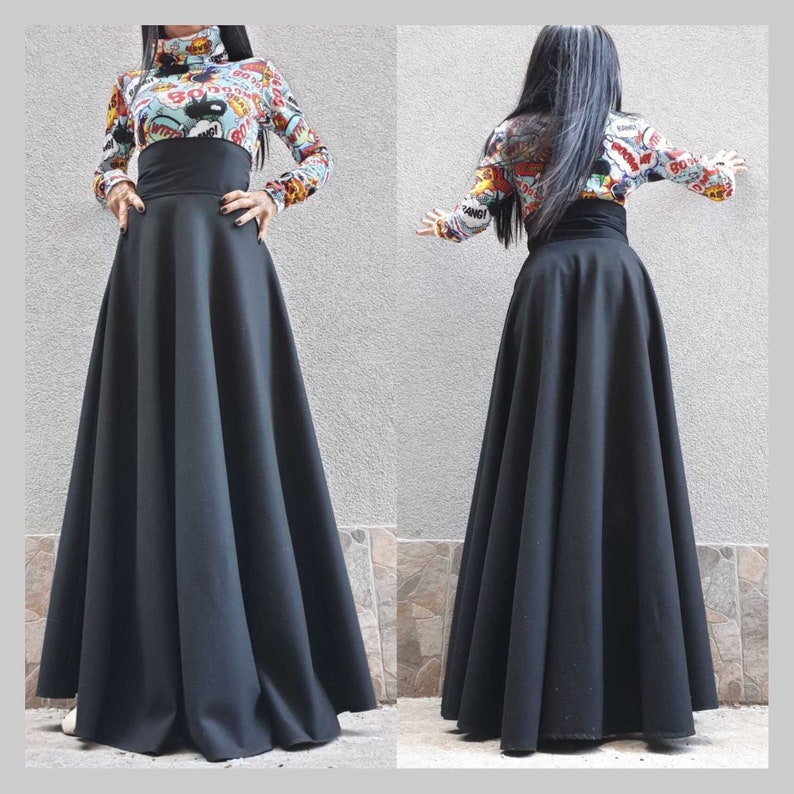
A high waist skirt is a skirt that rises up to the waist or higher to accommodate the woman's body shape and to highlight her curves. The high waist skirt is a type of skirt that has seen a resurgence in recent years and has even led to the creation of many new styles. This type of skirt is excellent for showcasing a curvy waist and creating a feminine silhouette. Also called an empire waist skirt sits high enough to cover your of lot of your belly and keep you looking sleek. A high waist skirt is great for petite women who want to make their legs and hips look longer.
Hobble
It sounds wild today, but once hobbled skirts were so popular that no one even knows who really invented them. It was the 1910s, and women wanted to express their freedom by getting rid of the trends that had held them down in the past. First, layered skirts and crinolines disappeared. Instead, women began to use skirts that hug their ankles.
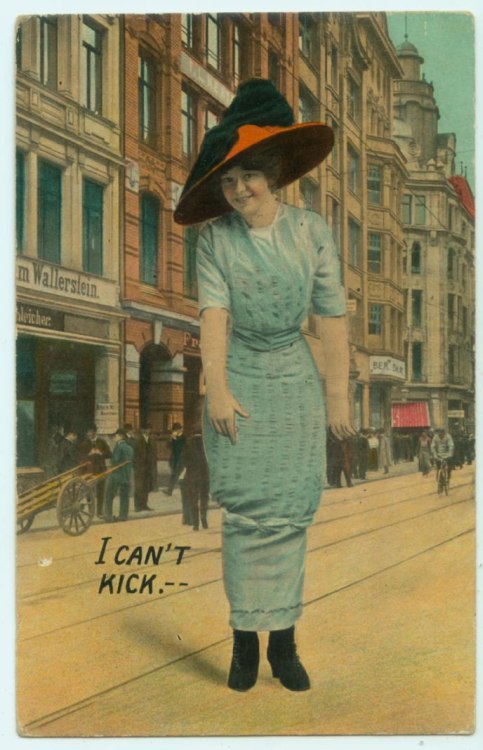
As soon as this kind of skirt made its way from Paris to the USA, it became a real “squeak” of fashion. Caricaturists drew cartoons of women trying to walk in skirts that hobbled them, and The New York Times wrote a gigantic article about the impact on the textile industry (after all, a huge number of skirt models were sacrificed to the new fashion). Historians called the new skirts “an absurd and immodest fashion ugliness”, but this trend continued until the First World War, which changed fashion around the world. New fabric restrictions and labor shortages in Paris led to the decline of the fashion industry and ended hobbled skirts for the shorter skirts.
Inverted Pleat
Inverted pleat skirts, also called inverted pleated skirts, are just like any pleated skirt but with one major difference: ordinary pleats face outwards and inverted pleats face inwards. This makes the two different kinds of garment appear distinctively different to the eye. The pleat type can be anything – box or knife for example; making them ideal as a basic element for changing different types of skirts as you may wish!
Layered
Layered skirt is a skirt that is designed with a number of layers that can be used to create a unique look. It is a type of skirt that is worn by women for a casual day out with friends, a date, a walk in the park, a casual party, a wedding, a formal corporate event, and other similar occasions. The layered skirt has evolved with time to become more sophisticated and elegant. It has become more fashionable and trendy with the introduction of new types of fabrics. The layered skirt is unique because it can be paired with different types of tops and is very comfortable to wear.
Lehenga
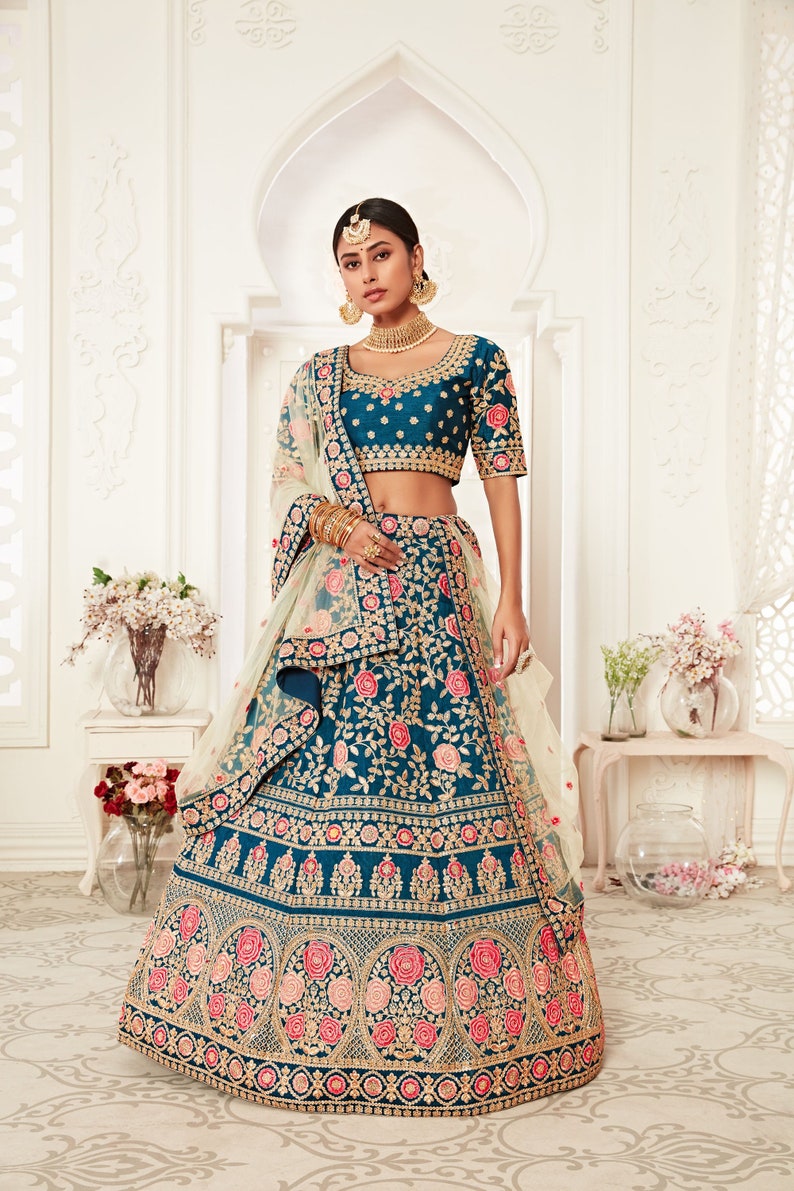
A Lehenga Skirt is a long, flowing, traditional Indian skirt that can be worn in order to make a bridal outfit look even more stunning. The Lehenga Skirt is worn over a choli (a traditional bodice top) and is accompanied by a dupatta (a traditional shawl). The Lehenga Skirt has become a very popular choice for brides in India, and this is because it not only gives a more festive and traditional and look and feel to the bridal outfit, but also because of the fact that it gives the bride a lot more freedom of movement than a traditional Punjabi. A Lehenga Skirt is often made from a piece of light fabric such as chiffon, and this is because it is easier to move around in.
Maxi
Maxis, maxi skirt, or maxiskirt are wonderful fashion staples for seasons throughout the year. These skirts can also easily transition from an evening look to a casual day outfit! It's perfect if you want something that you can wear just about anywhere and it transcends the seasons with ease. A variety of maxi styles including simple, sleek maxis and super fun printed maxis that definitely stand out from gray casual clothes.
A long skirt will add romance and femininity to your look, will make the figure more graceful, slender, attractive. It will become an integral part of the evening look, an outfit for a romantic date. It should be noted that the maxi-length ankle-length skirt with an inflated waist fits almost all girls, especially if it has a solid trendy color and is combined with high-heeled shoes.
It is important to properly combine maxi skirts with shoes – pairs on a flat and thick sole with a closed toe are considered ideal. The long skirt visually lengthens the silhouette, makes it slimmer, and adds height. The image will be harmonious if you follow the simple rule of combining contrasts. Solid color skirts can be worn with any top, but products with prints – only with light or bright T-shirts, blouses. It should also be remembered that long ankle-length skirts are worn with shoes on a flat or thick sole with an open toe, and on the floor – with a closed toe and heels or wedges.
Mermaid
A Mermaid skirt is a skirt with a tight fit that creates the illusion of a mermaid tail, that flares out at the bottom. It has been designed by Marcel Rochas in the 1930s. Mermaid skirts are usually long and made of a light, flowing fabric that creates an airy appearance. The skirt is flared at the knee, which is where the ambiance of a mermaid's tail begins. Also called a trumpet skirt this fashionable piece of garment is a popular look for bridal gowns.
Midi
Midi skirt has a versatile length that can be applied anywhere, anytime. It is believed that the products are suitable for absolutely everyone, regardless of body size and height. However, there are some nuances here. If you are not tall, opt for a tapered skirt just below the knee. The right length can easily add a couple of inches to your height. For women with curve hips, a black straight midi skirt will suit you, which will smooth out shapes and help you become slim and sexy. Here it is necessary to choose the length with care since ideally, the hem of the skirt should fall on the thinnest and most graceful place of the woman's leg. A win-win option would be midi length to mid-ankle. Such a skirt will add height, grace, and subtlety to the silhouette.
Mini
A mini skirt, or miniskirt is a skirt with its hemline at the upper thigh, generally at mid-thigh. The mini skirt has been popular since the 1960s as a symbol of youth and vitality. In Western culture, mini skirts have connotations of being sexually provocative clothing. The miniskirt was popularized in the mid-1960s by one of the Mods followers, Mary Quant, and has remained in fashion in various lengths ever since.
A micromini is a small miniskirt. This version of a miniskirt is even smaller than a normal-sized miniskirt due to its very short hemline. Some microminis can be worn with a regular or full-length top, while others demand a crop top. If you're feeling bold, you can wear a micro-miniskirt during the summer season.
Paneled
A paneled skirt is a skirt that uses horizontal (as well as diagonal) panels sewn together to make the skirt. The panels are joined together by seams, which can be either flat or in the shape of a dart. A paneled skirt is a very versatile type of skirt. By choosing how many panels and altering the width you can make a piece that looks almost straight or an incredibly twirly full skirt. A panel skirt may be the perfect solution if you don't have a lot of fabric to work with.
Peasant
A peasant skirt is a long ankle-length or even floor-length, free-flowing skirt with fullness around the waistline. Typically, this type of skirt is simple in design, can be designed with tiers, ruffles, or pleats.
The peasant skirt has its origins in the clothing worn by women in the villages. Peasant skirts appeared in the 19th century, they were sewn from a single piece of fabric (cambric or chintz), collecting it on a narrow belt. Peasant long skirts came into fashion in the 1960s, popularized by the hippie movement.
The second coming happened already in 2000 when the female population of the planet captured the craze for “floor-length” skirts. It is customary to wear peasant skirts with negligence and combine them with ethnic blouses and tunics. They are actively used by adherents of the boho-chic style – they can be worn with Chelsea boots, oversized sweaters, and wide-brimmed hats.
Pegged
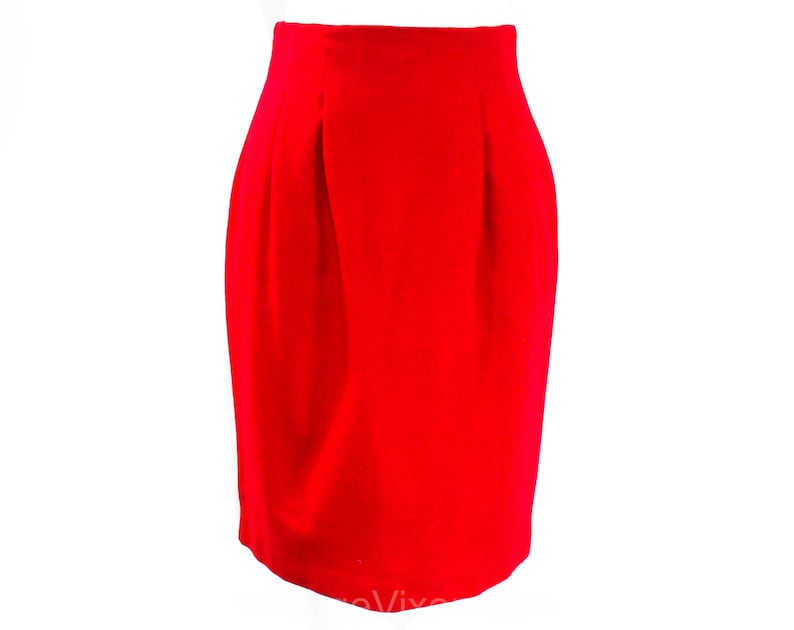
The pegged skirt, also known as the peg-top skirt, was inspired by men's pants. In the early 1900s, the peg-top look had become popular in menswear. To create a more distinct silhouette, this style added extra fabric to the hips of the pants, often in the form of pleats. The trousers narrowed down to the ankle from the enlarged hips. The larger hip style was more flattering on women than on men, and the peg-top style quickly found its way into women's clothing.
Pencil
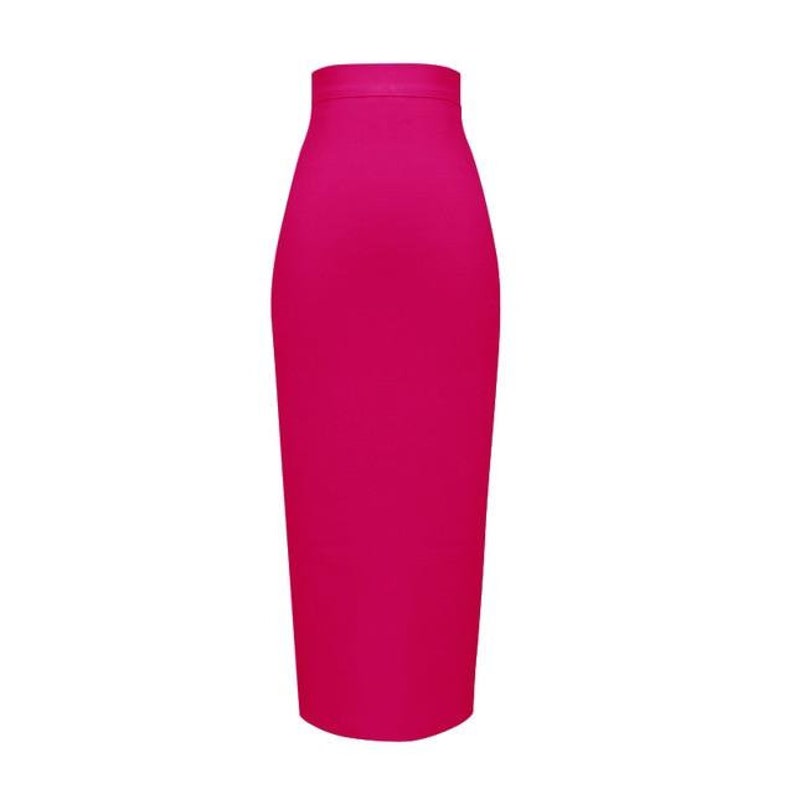
The pencil skirt as we know it today appeared much later – in 1954 when Christian Dior presented his collection with H-line items. In cut, they resembled the outlines of the Latin letter H – straight lines, accentuated waist – and looked favorably on the figure, as they visually lengthened the legs and shifted the emphasis to the hips. In addition, this collection has become an alternative to the boring silhouette of the new look, with its immense skirts and meters of fabric.
In the 1950s and early 1960s, the pencil skirt also called the fitted skirt, the tube skirt, and the straight skirt became a defining wardrobe item. A woman in a skirt like this could be an elegant intellectual like Grace Kelly, or a sexy seductress like Sophia Loren, who wore them with striped tops and fitted jackets. And Marilyn Monroe brought it to the status of a cult: thanks to her, the pencil skirt became a symbol of absolute femininity, and the hourglass figure became the standard of beauty.
Peplum
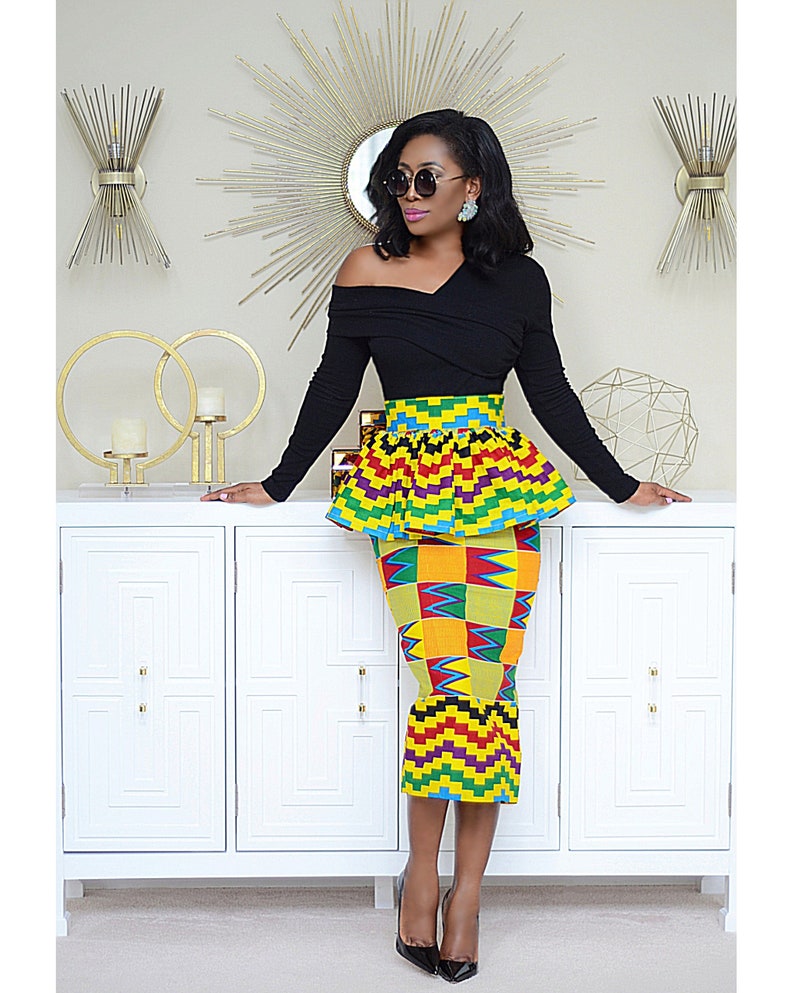
The peplum skirt or basque skirt is a style of skirt characterized by a fitted silhouette around the waist and thighs but flares out at the waist with an additional ruffle of fabric, thus creating a little poof. Coming from Spain historically, the peplum was really fashioned by the French. In the era of Queen Victoria, this element became an adornment for a man's suit, and a little later – a fashionable element in clothing for women. The peplum was sewn over a crinoline or a tulle skirt.
In the 20th century, the famous couturier Cristobal Balenciaga made a basque as a key detail in one of his collections. And it's no coincidence! Cristobal was originally from the small Spanish town of Hetheria, which was part of the Basque Country. This is how he wanted to highlight his roots.
Then the peplum disappeared from the catwalks, only occasionally appearing in the collections of designers (in the 70s, Yves Saint Laurent demonstrated a basque on clothes a couple of times), in order to return to the fashion world with brilliance these days.
Plakhta
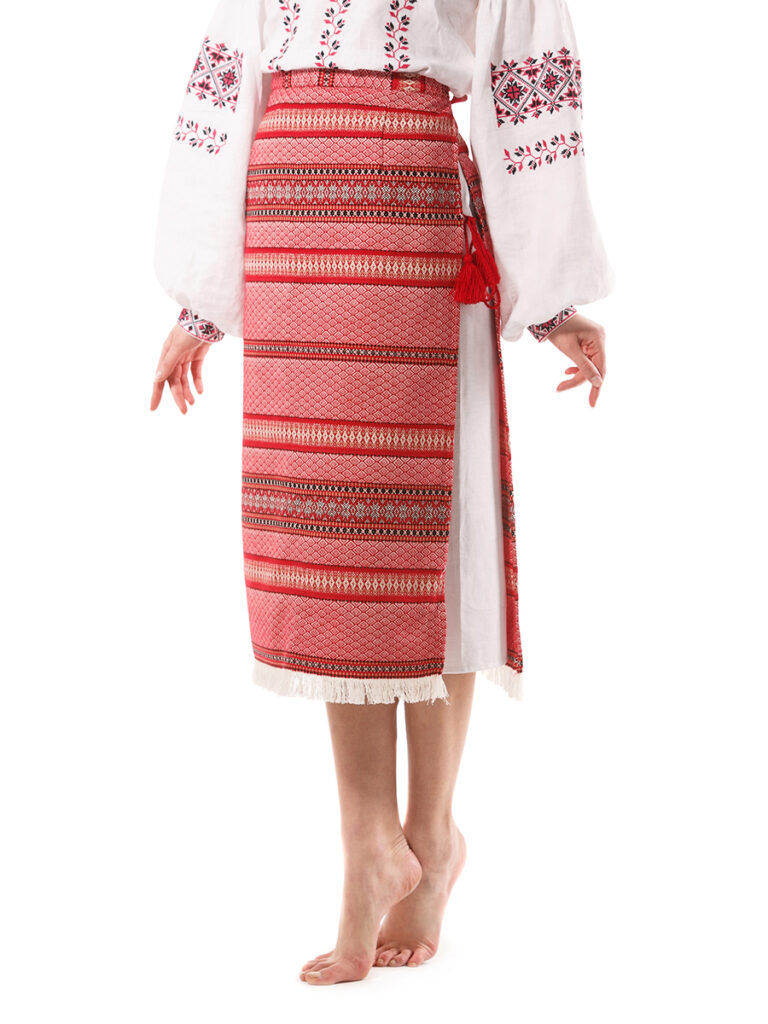
Plakhta traditional Ukrainian wrap skirt is usually woolen, with embroidered ornaments often plaid. It consists of two parts. An apron could be worn on the front. It is a very old piece of garment. In Cossacks times were made of silk embroidered with gold and silver threads. During the initiation, girls who had reached puberty could symbolically put on a plakhta, dedicating themselves to “virginity.” Plahta, as a fertility symbol, was to guard the sacred parts of the girl's body, bestowing fertility on the future woman.
Pleated
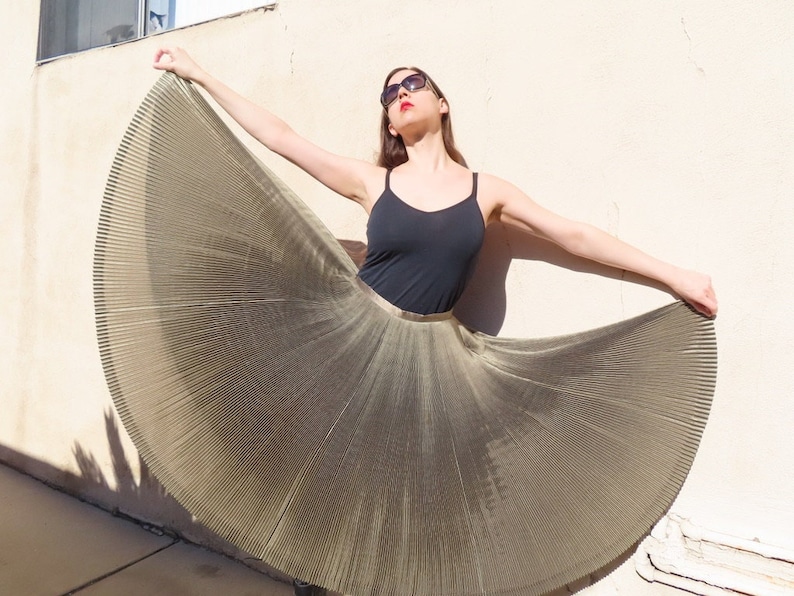
A pleated skirt or plisse skirt is a skirt with multiple rows of parallel pleats, usually made in one direction. There are about 13 types of pleats, but the most famous one is the accordion. The accordion pleat is ironed into strips and then sewn like an accordion together. Pleating can be of different types: both wide and narrow. Pleating requires about three times more fabric than the width of the finished skirt. Today, pleating is used for various types of fabrics and for various items of clothing: dresses, skirts, blouses, even trousers, and coats.
Accordion skirt presents an open effect, heavily ironed folds, with a large bend. Depending on the fabric and the width of the accordion skirt distinguish the following shapes of the skirt: full circle pleated skirt, three-quarter circle, or half-circle pleats skirt (sometimes also called the full sun, three-quarter sun, and half-sun pleated skirt accordingly). A full circle accordion-pleated skirt could consume five-four times the skirt width.
Knife-pleated skirts are a bit different than upper one cause sharp pleats that come in and out, overlap one other.
Pleated skirts can be traced back to ancient times. Ancient Egypt and Mesopotamia were the first to “discover” pleats. Pleated skirts first appeared several thousand years before our time and were considered a purely masculine garment. Then Egyptian women borrowed pleated skirts from men and never parted with them. Pleated skirts arrived in Europe in the 19th century and quickly won the hearts of all fashionistas. The folds made their way to Scotland, where they became ingrained in the world-famous Scottish kilts, which are traditionally worn only by men. Pleating has become especially popular in Japanese school uniforms.
With its cuteness and tenderness, the pleated skirt is practical, versatile, and appropriate for a wide range of occasions. You can wear the product on vacation, at work, for business meetings, friendly parties, or to the movies. This eye-catching element of the feminine ensemble draws attention and emphasizes the style. The ability to conceal figure flaws while emphasizing their merits is the unique advantage of corrugated designs.
Prairie
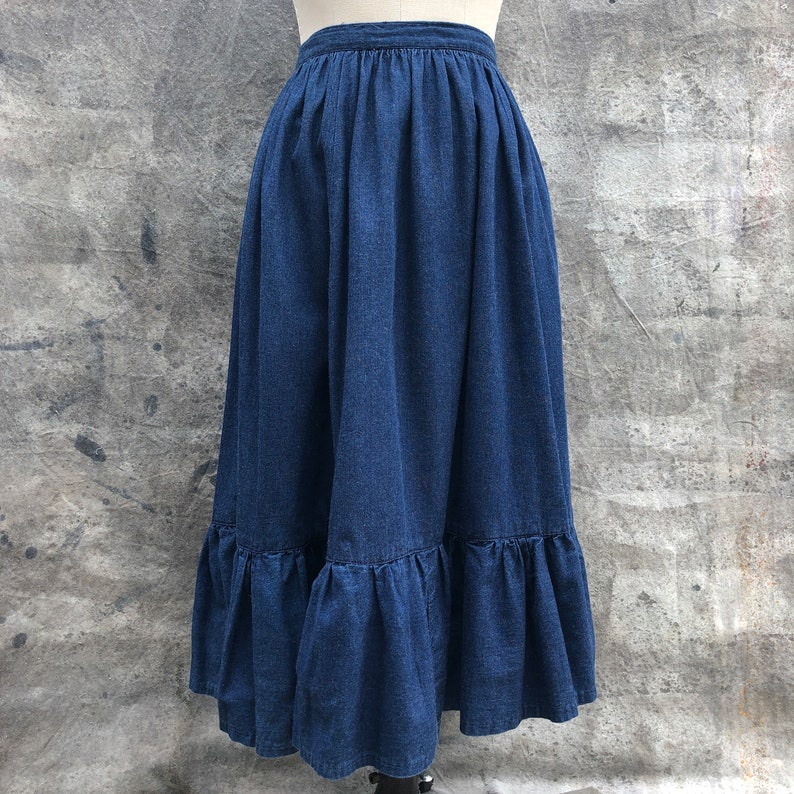
A prairie skirt is a woman's skirt that is gathered onto the waist and falls in soft folds, ruffles, or tiers to the floor. The style is most often associated with women's workwear from the American Midwest in the early 19th century.
The variation of the Prairie skirt is a boho skirt or cottagecore skirt. A boho skirt is a type of skirt that hippies wore during the 1960s. They are usually long and flowing, and are usually made of calico fabric. Also, women often recycled feed sacks into blouses and skirts because of printed small floral patterns.
Long-length many-tiered prairie skirts of chiffon, voile and other lightweight fabrics were in a fashion modern days as part of the cottagecore trend in 2020.
Rah-Rah
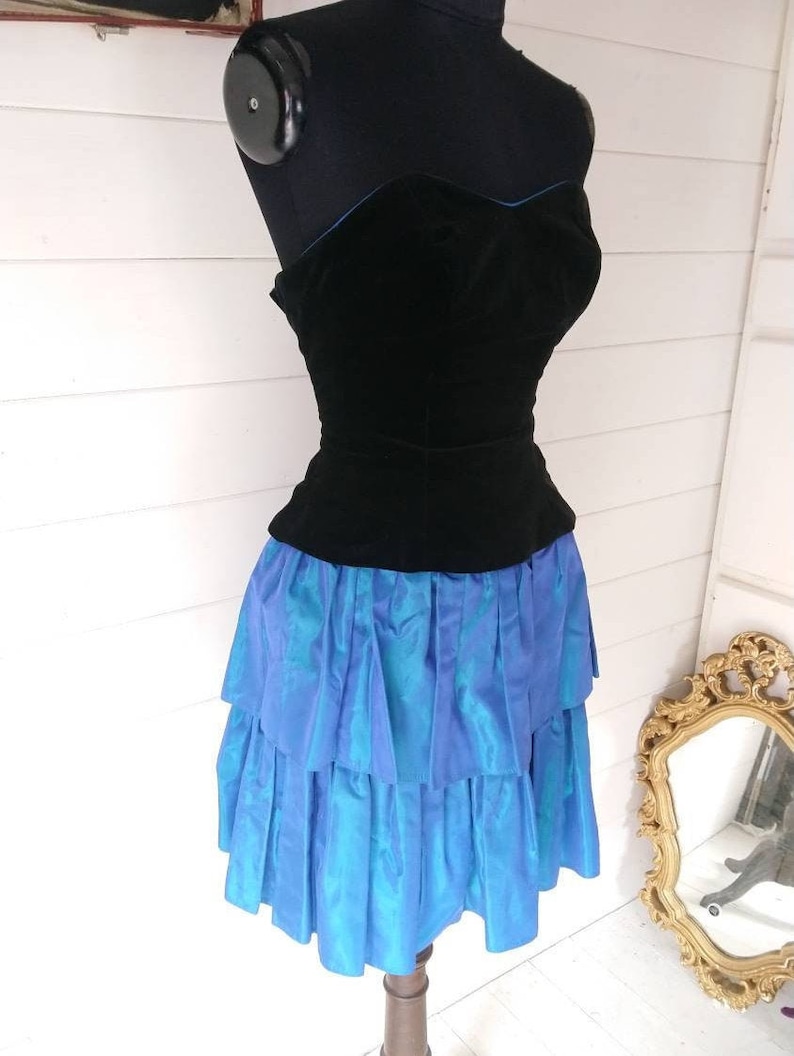
The rah-rah skirt is a type of skirt that is often worn by cheerleaders. It is usually made of tulle, and it is sometimes called a ra-ra skirt. It often has two or more tiers that overlap. You can create a new look with an oversized sweater since the skirt has a classic cheerleader feel but at the same time is modern and chic.
Ruffle
A variety of skirts fall under this category, such as a pencil skirt with a ruffle on the front or a tutu skirt. You can find them in many different colors and fabrics. As long as there is a ruffle on the skirt, it's a ruffle skirt!
Sarong
Sarong is a long and wide piece of fabric worn by both men and women in Oceania and Southeast Asia. Sarongs are usually made from light-weight fabrics, either cotton, viscose, silk, or other materials. They are often used for skirts, but can also be worn as tops or dresses.
The pareo or beach wrap, as the beach version of this clothing is known, is most commonly worn when going to the beach, pool, or sauna. You can tie it in a new, original way each time, resulting in a one-of-a-kind outfit.
Skorts
Nowadays, the term “skorts” is most commonly used to refer to scooter skirts, which are very popular among young women. Although the term “skirt” is often used interchangeably with “skort,” it technically refers to a garment that has a skirt at one end and pants at the other.
Skirt-shorts came into vogue more than 200 years ago. Initially, it was used only as clothing for cycling in the warm season, in everyday life, it was impossible to meet a woman in such a skirt. However, the original style, as well as comfort and practicality have served because, in our time, the skirt-shorts have gained incredible popularity, both among naughty girls and businesswomen, as well as among ladies of respectable age. The front of the skorts looks exactly like a regular skirt, and only the back can tell that these are shorts. This model is ideal for girls who prefer to wear a mini but are afraid of getting into an awkward situation, such as on public transport or stairwells with slots.
Slip
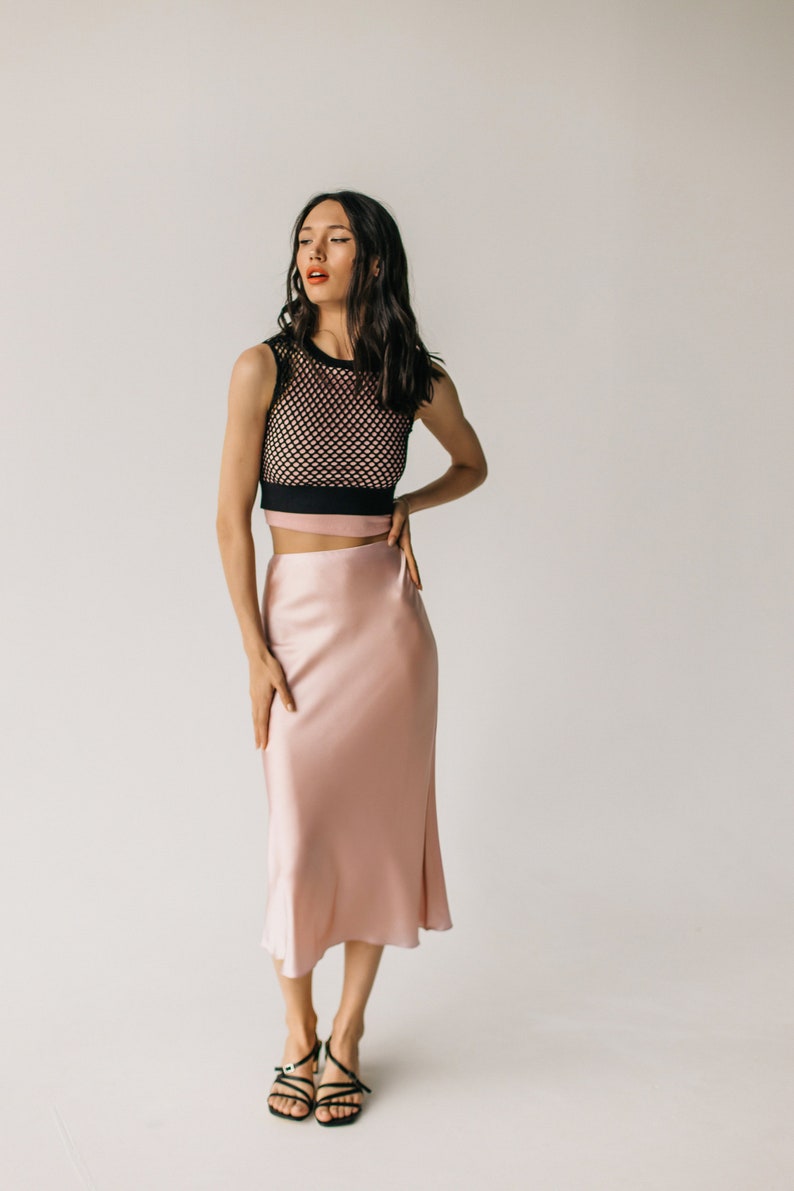
Slip skirt is a solemn novelty of the 2019 season. It is reminiscent of the petticoat that ladies are used to wearing underneath. But this petticoat exists now, as an independent skirt, and is now able to please not only Instagrammers. It is from the lingerie style category, so looks quite feminine. The material in which it will be possible to see it gives it even more charm. Slip sewn from flowing fabrics such as satin or silk. Slip will perfectly fit into all sorts of looks: party, office style, and an evening look.
The style is closer to the underwear, but it is worn on top, like other basic clothes. In some models could include lace on it.
Such a beautiful little thing has no age restrictions. Correctly selected fabric tone and style allow both mature women and very young girls to wear it.
Tea-length

The tea-length skirt came to us from England. This is the definition for dresses and skirts, in which it was customary to appear at a traditional tea party. The items were mid-ankle length, i.e. a cross between midi and maxi.
Grace Kelly brought real popularity to tea-length dresses in the 5s of the 20th century. She showed that such a dress and pumps make the figure more slender and fragile.
Modern fashion trends advise wearing tea-length skirts with less conservative pieces. So, they go well with cropped tops, and with simple T-shirts, and even with sports-style T-shirts.
Tennis

A tennis skirt is a box pleated mini skirt that has inside shorts sometimes with pockets where you can put a tennis ball or phone. Tennis skirt-shorts have crept into our daily lives in 2021. Tennis skirt-shorts are in trend among young sports girls. Skirt-shorts for tennis are sewn in a free cut so as not to hinder movements. After all, comfort is necessary during such an active game. It is convenient to go for a walk, do various sports – ride a bicycle or roller skates. It looks great with sandals, low-heeled pumps, slip-ons, and neutral accessories.
Tiered
A tiered skirt is a skirt in which the fabric creates the effect of a gradual and smooth expansion downward, layered all the way down and giving the appearance of multiple tiers. Because the skirt is more flashy, it often gives it a layered, ruffled appearance combined with hugging hips, that can look very feminine and dressy, especially when worn with a more simple top.
By “playing” with the total length, the number of tiers, the gathering factor, the selected fabric, you can create a variety of silhouettes. Therefore, we claim that such a skirt will look advantageous on any type of figure: “pears”, “rectangles”, it is only important to choose the right lines.
Trousers skirt
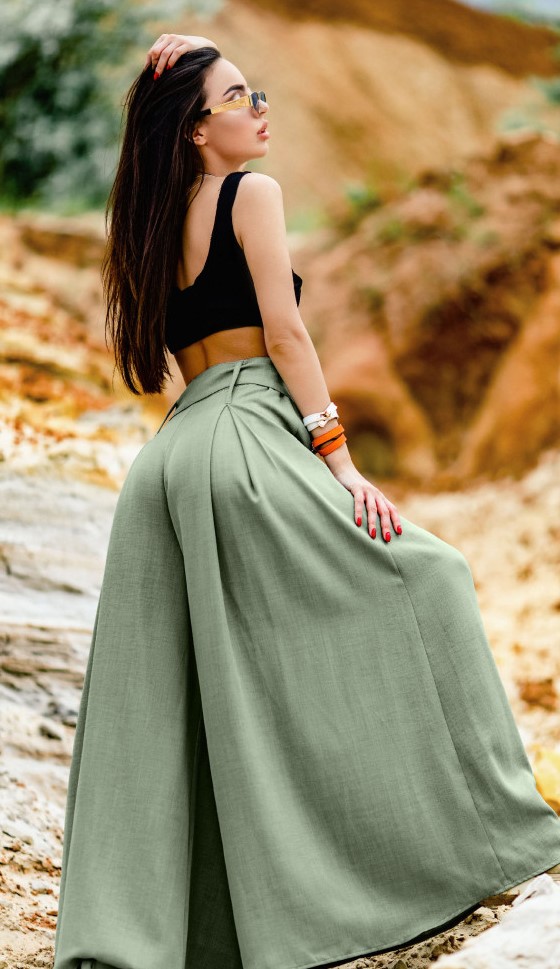
The skirt-trousers or trousers skirt was invented in the 1930s as part of a women's sports suit. However, women liked it so much that it gradually moved into the category of everyday clothes and even clothes for going out. Skirt-trousers are a combination of a long skirt and wide-leg trousers, which makes it a very comfortable, feminine, and practical wardrobe item. Today, bright and elegant models of floor-length or mid-calf skirt trousers are in fashion. Such a skirt fits nicely around the waist and the upper part of the buttocks widens from the widest part of the hips, and smoothly descends downward.
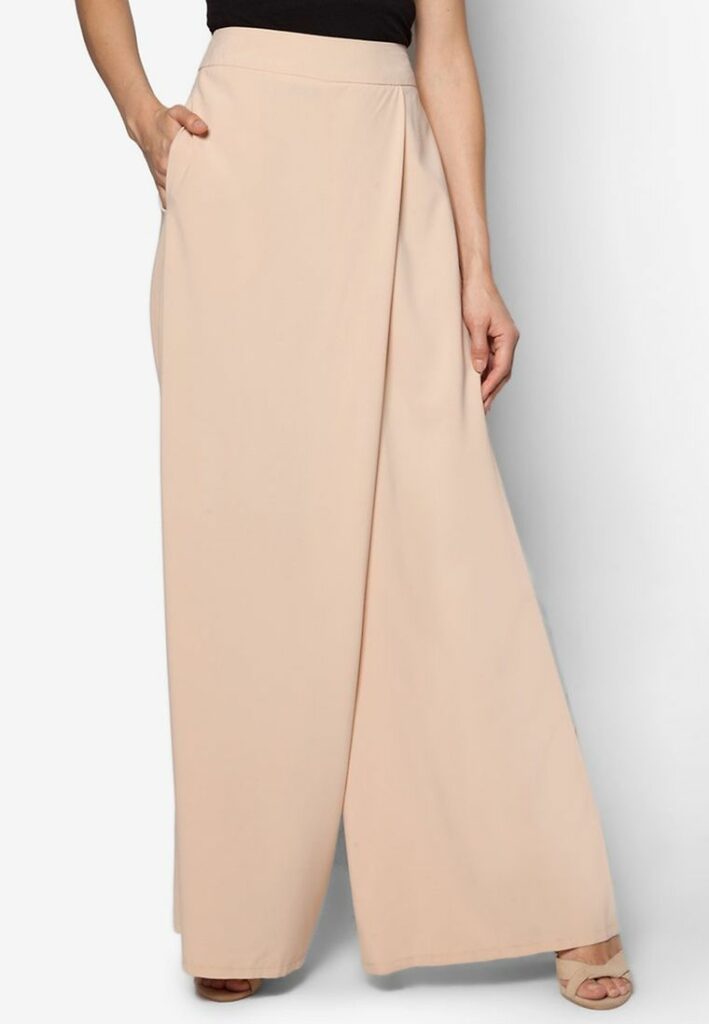
In addition to the classics, the wrap trousers skirt is the most original and popular model right now. It resembles a classic loose-fitting skirt even more but retains all the benefits of a fashionable and functional hybrid item. The wrap is formed in the front, and it can be as simple as a small piece of fabric revealing one of the legs diagonally, or it can completely create an imitation of a skirt in the front.
Tulip
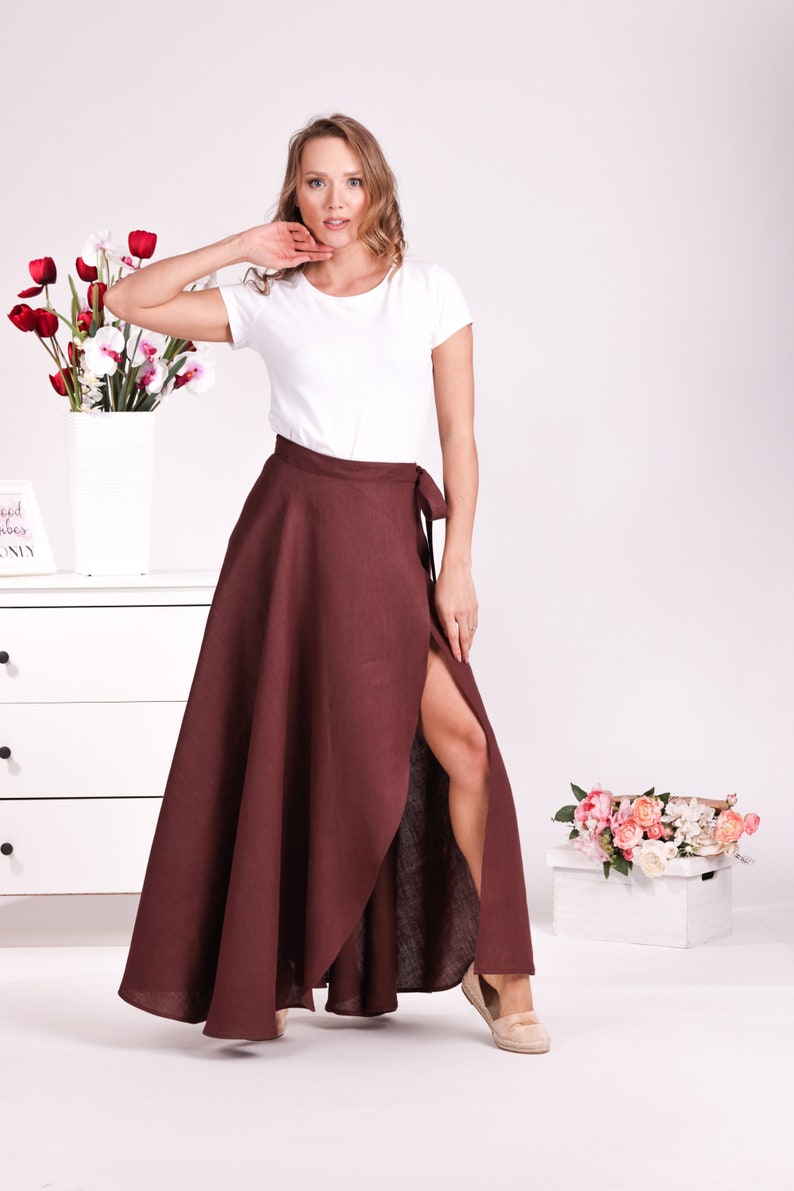
The tulip skirt got its name due to the fact that its shape resembles a tulip bud. The tulip skirt tightens at the waist level, flows down the hips, and tapers downwards. The classic version of the tulip skirt is the midi-length just above the knee and the scent that creates the effect as if the tulip petals in the bud are lying on top of each other.
Christian Dior invented the tulip skirt in 1953, and it quickly became a fashion icon. The length of the tulip skirt can now be mini, and below the knee, and even reach the shin. Designers have created a huge variety of models by decorating her belt or hem with various frills, bows, flounces, layering effects, adding pockets.
Tulle
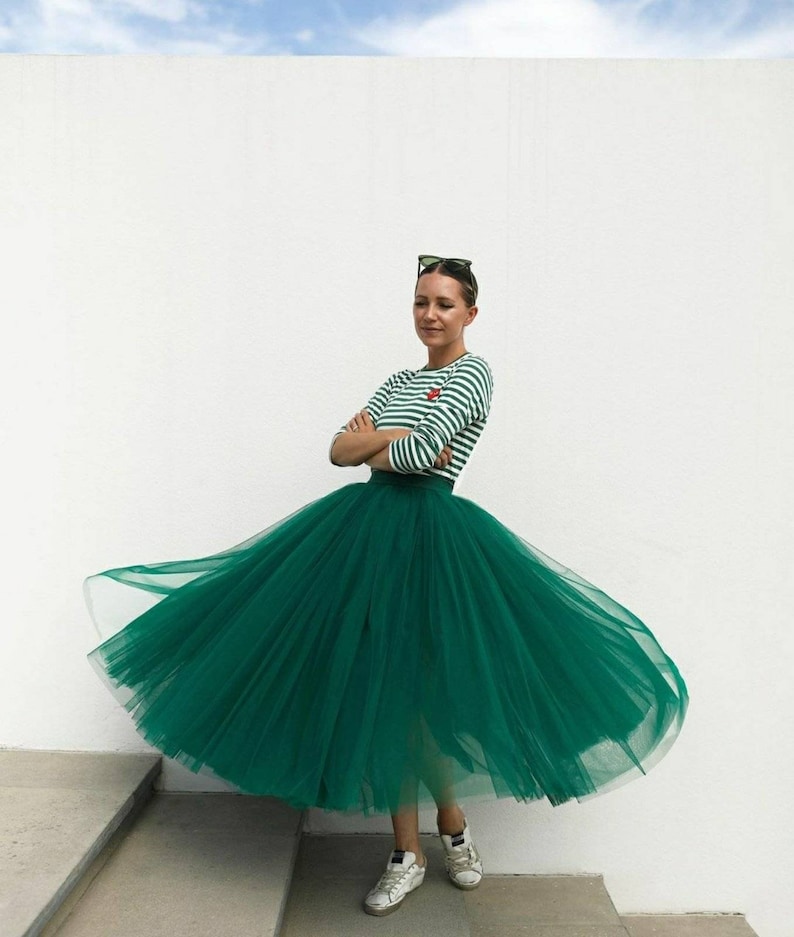
The tulle skirt is a fluffy skirt on a belt or elastic band, made of several layers of lightweight, transparent, airy, mesh fabric that is mostly associated with tutus, ballerina skirts. Sometimes it is tulle, organza, transparent mesh, and others.
Tutu
A tutu skirt, or a ballerina skirt, came into fashion from ballet. Tutu skirts appeared in the first half of the 19th century.
The first ballet tutu made of tulle was made in 1832 for the famous Italian ballerina Maria Taglioni, who performed the role of the Sylphide Fairy in the ballet of the La Sylphide by the composer Jean-Madeleine Schneitzhöeffer. This model was invented by the ballerina's father, Filippo Taglioni, an outstanding choreographer of the Romantic era, and the sketch for the skirt was made by the French artist Eugène Lami. The tutu, which is a multi-layered fluffy skirt, made a splash. Over time, the outfit has become a real symbolization of world ballet.
A classic tutu consists of 10-12 layers of fabric. The length of the skirt ranges from the shortest mini to the maxi. Such skirts can be decorated with satin bows, ruffles, flounces, and others.
Underskirt

The underskirt is simply a skirt that is worn under the upper skirt to create opacity and/or soft fluffiness (then flounces are sewn onto it at the bottom). It can be narrow or wide, but the principle is simply sewn fabric. In the sixties, these were worn, they flew very beautifully in rock and roll dances.
A structured underskirt is called a petticoat or crinoline, which is a wide skirt with rigid hoops sewn in at the bottom. That is, hoops hold the top skirt and give it volume at the bottom. Used in wedding dresses. Shuttlecocks are also sewn onto it, but the volume is still achieved by a rigid hoop.
Wrap
The wrap skirt can be of any shape and length. Such skirts are wide or narrow, simple or with decorative elements. Coming from Ancient Egypt wrap skirts are made from materials of various textures and colors and can be worn at any event in any season. What unites them, in essence, is only the presence of such an element as a wrap.
In the latest models, the wrap is predominantly located in the front and side. This creates a graceful triangular that looks very feminine.
Yoke

Many girls wear yoke skirts or yoked skirts. But, few of them know that an unusual word by ear can be directly related to the design of clothes. The yoke is a specially tailored piece that is part of the skirt itself, an extended waistband that goes from the waist to the hips. Very often, fashion designers use a yoke when creating women's, men's, and children's shirts, dresses, trousers. A yoke (wide or narrow strip) is sewn to the main panel of the skirt. The full length of the product includes the length of the yoke.
Men’s Skirts
Most people would assume that skirts are worn only by women. In reality, men have been wearing skirts for centuries. In certain cultures, they still do to this day. Men's skirts were originally worn for practical reasons, but these days masculine skirts are primarily worn for ceremonial purposes.
Fustanella
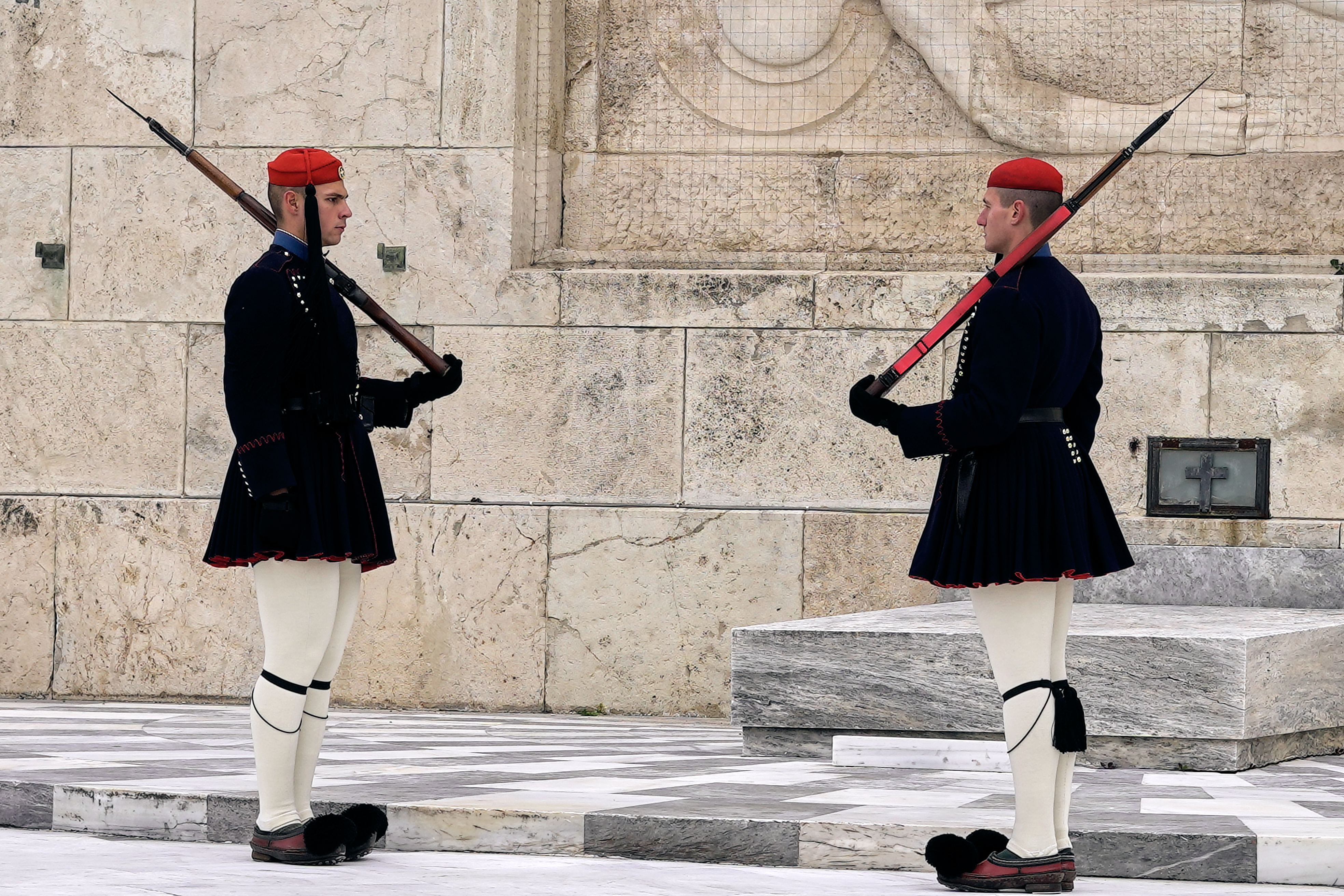
Fustanella is the traditional skirt of men in the Balkans. In the 19th century, it became part of the Greek military uniform. Currently, this wide two-layer wool pleated skirt is worn by the Evzones, the elite infantry of the Greek army.
The skirt is fastened with a special belt that provides a secure fit at the waist. There are exactly 400 folds on the Greek fustanella, which symbolize the number of years the Greeks spent under the Ottoman yoke. By the way, the infantrymen must monitor the condition of their skirts themselves: they iron them on their own every day.
Kilt

The most famous men's skirt comes from Scotland and is part of the national costume. These days, Scottish men wear kilts to weddings or formal occasions. The history of the appearance of the kilt is connected with a large blanket, which men turned around during the hikes: it warmed up, could be used as a blanket, and in case of an attack, it was easy to throw it off.
Traditional Scottish kilts are made from pleated tartan, a Scottish wool fabric with a checkered pattern. The skirt is fastened to the belt with belts and buckles. In addition, a sporran is worn on the belt – a special bag for the necessary little things.
Longyi

Longyi presents a wide piece of fabric, reaching 2 m in length and 80 cm in width, which is worn in the manner of a skirt by the Burmese. Similar clothing is common among women in the region, but men's Longyi is tied in a knot at the belly and women's tucked in at the side. These casual skirts are usually made of satin or cotton in subtle, practical colors, and for special occasions, more expensive fabrics are used, often decorated with patterns.
Such clothing provides ventilation and protects from the heat. If it becomes uncomfortable for men in skirts to move, they can at any time convert them into shorts bypassing the hem between the legs and securing it to the belt.
Sulu

Men in Fiji also wear skirts – sulu. Such clothing appeared on the islands in the 19th century and is associated with colonization: it was brought by missionaries from the Tonga archipelago. The locals wore skirts to show their Christianity.
Skirts are not only part of the national costume – they are included in school and military uniforms, as well as in the dress code of officials and office workers. The length of the skirts is just below the knee, but can also go up to the ankle. The item is tied around the waist or fastened with clasps.
Ihram

Ihram is a unique dress worn by Muslim pilgrims during the Hajj. At the same time, men put on two white bedspreads: one of them is fastened with a belt at the waist and covers the lower part of the body, and the second is thrown over the left shoulder and draped diagonally.
By wearing the same simple clothing, believers feel unity and solidarity. And they also emphasize that they are equal in the face of Allah because, in appearance, a wealthy person cannot be distinguished from a poor one.
Hakama
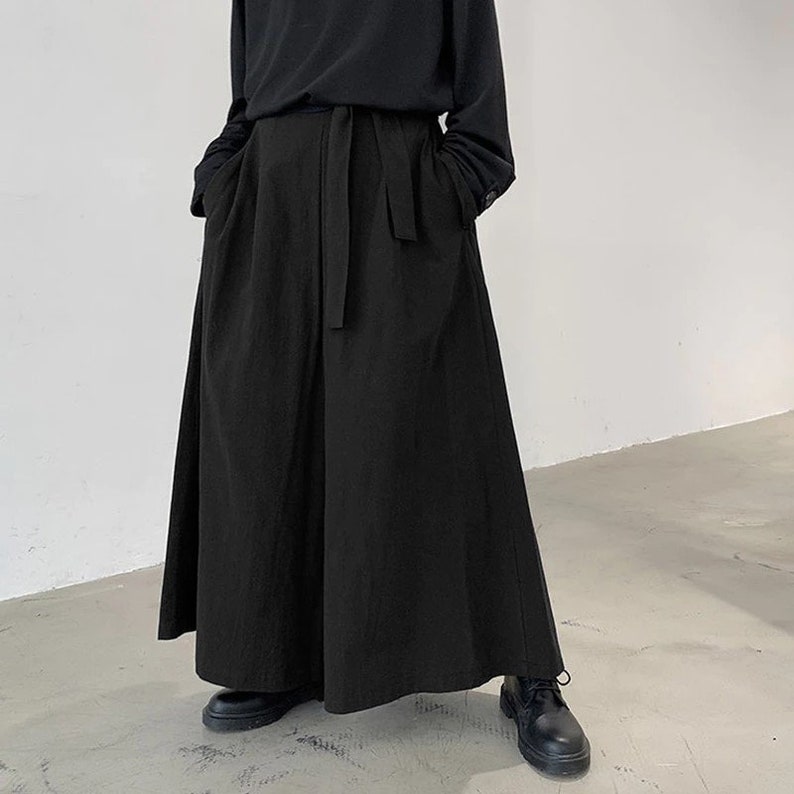
In Japan, males wore hakama skirt-pants over a kimono, which appeared in the country in the 6th century AD. NS. thanks to the influence of Chinese culture. Initially, only men wore it, but women gradually began to do so as well. Nowadays, men rarely wear hakama. This is most common during tea ceremonies or official events. Martial artists and others wear them as well.
In addition, the hakama has seven-folds, five in front and two in back, which may have a philosophical explanation, referring to the seven virtues of the samurai code, or a practical reason associated with unequal length of steps with different legs. Correctly folding a garment without damaging the folds is a separate art that requires a lot of skill.
Gho

In Bhutan, the traditional men's clothing is the gho robe, which is fixed at the waist with a fabric belt. It is worn with a kabni scarf and knee-length socks. This garment was introduced in the 17th century by the founder of the state, Shabdrung Ngawang Namgyal. Thus, he wanted to emphasize the originality of the culture of his country.
Today, gho is mandatory for schoolchildren and government officials. These clothes are so tricky to put on that even adult men have to resort to the help of strangers.
Materials
Skirts are made from a variety of materials, which influence how any skirt type fits and feels. Choose skirts based not only on their style but also on their fabric.
Cotton
Cotton fabrics are the best solution for those who care about their health because cotton is always reliable, comfortable, and hypoallergenic. Among its undeniable advantages are:
- high strength and durability;
- breathable qualities;
- thermoplasticity – the ability to take various forms under the influence of high temperatures (for example, after ironing with an iron);
- high thermal protection characteristics – perfectly retain heat and dryness;
- easy cleaning and ironing;
- interaction with organic solvents (vinegar, alcohol), which allows you to remove even the most difficult stains.
At the same time, do not use citric acid, iron at full mode, and expose cotton to prolonged exposure to sunlight.
Cotton Memory
It is also known as polished cotton, but many do not know what kind of fabric it is or why it is so often featured on clothing tags. It gets its name from its sleek and shiny face, making it a good choice for smart suits, dresses, blouses, and more.
The description of the cotton-memory fabric is short and concise: it is remarkably breathable, allowing the skin to breathe, does not wrinkle when washed, looks luxurious and elegant.
Denim
Denim is a tough cotton fabric with a twill weave pattern and diagonal ribbing. It is a type of warp-faced fabric that is commonly used to make jeans and skirts. It is a popular and comfortable material.
Denim skirts are extremely versatile and can be worn as casual, formal, or elegant types of skirts. These skirts can also be worn in the workplace if they are cut in a specific pattern. They can be embellished with a variety of crafts such as rhinestones, buttons, tye-dyed glued or paints, and other materials.
Jersey Knit
Jersey is knitted fabric. The structure of the fabric is represented by intertwined loops, a connection of rows and columns, and not perpendicular warp and weft threads (as in a plain or twill weave, for example). Properties characteristic of knitwear:
- elasticity and flexibility;
- extensibility;
- softness.
The material is made using special textile machines that automatically knit a single-row fabric. Currently, not only wool is used for the manufacture of jerseys, but also:
- cotton is a natural plant thread, hypoallergenic, economical and affordable;
- silk – a thread made from silkworm cocoons, elegant, expensive and very durable;
- viscose and bamboo – artificial fibers from wood pulp and bamboo stems;
- polyester – synthetic polyester yarn, very durable.
Leather
Leather has been used to make clothing since the dawn of time. This material is extremely long-lasting.
Like centuries ago, now natural leather is an expensive pleasure. It is also believed that this material is inhuman and its use is unacceptable. That is why they invented an economical, reliable, and decent-looking artificial substitute – vegan leather.
Linen
Linen fabrics are one of the few that are made from completely natural raw materials. Linen has valuable hygienic properties, for example, the ability to remove heat and moisture. In hot weather, a person dressed in linen clothes has a body temperature 3-4 degrees lower than in clothes made of other fabrics (especially synthetics).
It has also been proven that wearing linen clothing prevents some diseases since it has rare bacteriological properties – neither fungus nor bacteria can get along on it. This completely clean, eco-friendly fabric is considered a natural antiseptic. Flax also kills germs and various infections, wounds under linen dressings heal faster. Flax contains silica, which inhibits the growth of bacteria.
Linen-blend skirts are incredibly comfortable and low-maintenance.
Poly-Cotton
This is a cotton-polyester blend that is popular for skirts because it is easy to care for and takes a long time to wear out or stain. The polyester makes the skirt durable and wrinkle-resistant, while the cotton makes it soft and comfortable.
Because cotton is typically more expensive than polyester, this blend is an excellent way to enjoy mostly cotton fabric at a much lower cost.
All polycottons differ from natural cotton fabrics in the following main advantages:
- high wear resistance;
- reduced crease;
- minimal or utterly absent deformation during long-term operation;
- minimal or no shrinkage;
- hygienic and environmental safety;
- ease of care;
- less cost than all-cotton fabrics.
Fabrics with a polyester content of more than 35% can have noticeable disadvantages:
- static electricity appears;
- poorly breathable;
- small pellets.
Poplin
Poplin is a plain weaving material that has been known for over 5 centuries. At first, it was made only from natural raw materials. Poplin is now woven from a variety of fibers. The main characteristic of the fabric – the type of weaving with a certain ratio of the thickness of the weft to the warp – remains unchanged, very strong fabric.
Poplin skirts are wrinkle-resistant and easy to iron.
Rayon
The rayon is an artificial silk fabric made from viscose. The elastic, shiny, lightweight material has been used for almost one and a half hundred years for sewing practical, elegant types of clothing, skirts included, household items.
Seersucker
Seersucker fabric is difficult to mistake for another. Today as a basis for it used both artificial threads synthetic and natural (cotton, wool). The crumpled structure of the fabric is painted in a variety of patterns. This effect is achieved by heat treatment in the factory.
A crepe is a common name for this type of material. You must know that crepe is the name given to a fiber-weaving process. In this method, the torsional force of the fibers is multiplied by several, resulting in a solid fabric—the material gains both strength and “elasticity,” the ability to stretch, and a wrinkled appearance.
Stretch Cotton
With a little bit of “give,” the stretch cotton provides just enough flexibility to be both comfortable and adaptable. All-day comfort and durability are the hallmarks of this material's construction because of its two- or four-way stretch properties during the manufacturing process.
Twill
Cotton, silk, and polyester are common materials used in twill-woven fabrics, including parallel and diagonal ridges. A twill skirt's many qualities include its resistance to stains, longevity, and appealing appearance.
For skirts and other clothing items, the unique look of twill helps keep them wrinkle-resistant and crease-resistant.
Vegan Leather
Vegan leather is a material that consists of two layers. The basis is a woven fabric. A polymer layer is applied on top, painted in the desired color, and given a characteristic texture. Polymers are a substance made up of many molecules, organic and inorganic. Cellulose, proteins, rubber, and polyethylene are all polymers.
In 1963, eco-leather was first made in America, and a year later, Japan independently presented its own developments in this area.
Polyurethane, a very durable rubber substitute, is used as a “leather-like” coating. Vegan leather made of polyurethane, sometimes called pleather, is safe, non-toxic, and does not emit strong odors. Under the microscope, the coating is a porous structure that allows air to pass through perfectly.
As a basis, use:
- cotton – natural fabric, the fibers of which are obtained from a plant called cotton;
- polyester is a synthetic polyester fabric that resembles wool or cotton, depending on how the fibers are made.
Thanks to the woven base and porous polyurethane, vegan or eco-leather is highly breathable and better than natural. If the polymer coating layer is increased, the fabric is more robust and more rigid. The characteristic pattern of the surface, the texture, in everything similar to natural, the vegan leather receives after processing by pressure.
Velvet
Velvet skirts have been making a comeback in fashion recently, and many collections have featured velvet skirts on their catwalks, demonstrating the refinement and elegance of the wearer. Luxurious and pricey, velvet has an appearance that evokes paintings of the nobility or vintage-inspired fashions.
Today, velvet skirts are worn for more than just evening gatherings and festivities. So gorgeous that it is imperative that fashionistas wear them during the day. New technologies started adopting polyester-based synthetic velvet in recent years because of new advancements, which have cut the cost of the fabric and made it easier to care for.
Wool
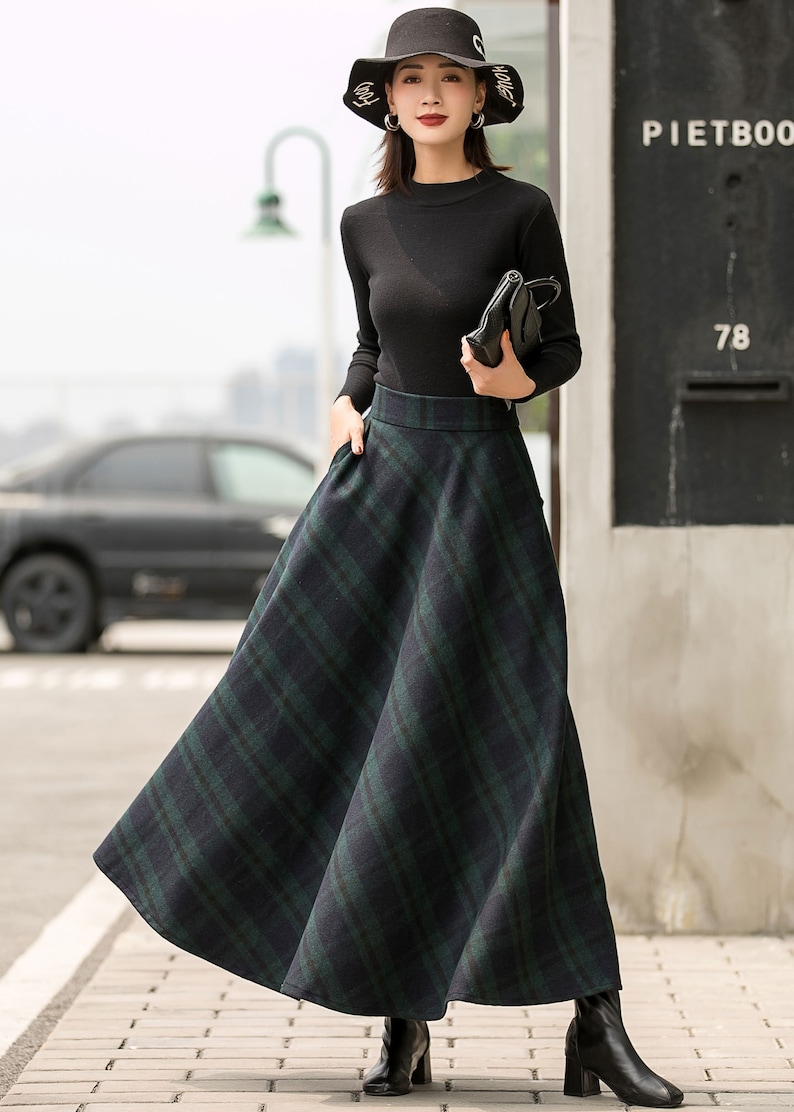
Warm, breathable natural fabric that holds its shape is ideal for those who prefer to combine comfort and beauty. Woolen skirts can be worn by all ladies, regardless of age and profession, the main thing is to choose a suitable model that will flatter the figure.
FAQ
What are the functions of different types of skirts?
Skirts emphasize femininity and create a practical or elegant look for a specific event. In addition, different types of skirts perform various functions to hide some figure flaws or reveal them.
For example, a pencil skirt emphasizes hips bend and legs slimness, but at the same time, it is not recommended for very narrow or massive hips. A Tulip skirt increases the difference between the waist and hips while hiding height and shortening the legs; a wrap skirt distracts attention from problem areas, mask the tummy, but the abundance of folds can produce the opposite effect. The A-line skirt hides too narrow or wide hips and shortens the legs; the sun skirt with emphasizes the waist makes the hips more massive.
How many types of skirts are there?
There are many different kinds of skirts. If you include historical skirts and traditional skirts from around the world, the total number of skirts becomes even greater. Skirts change almost every year, so designers create new designs for them all the time.
Which types of skirts are in fashion right now?
Maxi and asymmetrical skirts are popular right now. We must also acknowledge that the miniskirt has returned. Prada sent out skirts styled with oversized leather biker's jackets. We could not help but noticed just how many people were wearing mini bouclé skirts over recent months. Inspired by men’s fashion, Chanel created the iconic bouclé jacket and skirt set in the 1950s, which has been considered one of the stylish things you can ever wear.
Which types of skirts are easy to sew?
The easiest to sew is a straight skirt with a slit made of stretch fabric. A minimum of seams and the fastest … Again, no patterns are needed.
Can you wear skirts with sweaters?
A skirt with a sweater is a very trendy combination, but you need to know how to choose such clothes correctly so as not to look awkward. In the case of a wool sweater, we advise you to pay attention to large knitting like a pigtail and “make friends” with a skirt made of silk, satin, or other shiny material. A voluminous sweater with a skirt made of thinner material will emphasize the silhouette's fragility. The leather skirt is one of the most trendy models. It will look great in combination with an oversized sweater – if you wear a sweater with a skirt, we advise you to tuck its edge into the belt so as not to “lose” your waist. Very popular this season is also a pleated skirt with a sweater. Choose bright midi or maxi lengths and mix them with oversized sweaters in neutral colors.
What are some types of short skirts?
Some types of short skirts are skating, mini, micromini skirt, scooter (skorts), tennis skirt. At the same time, you can adjust the length in various types of skirts, as if a-line type, tiered, pleated, tulip, circle, etc.
What do you call skirts that flare out?
The skirt that flares out we call trumpet skirt. This style combines a pencil skirt and a flare. The top of the skirt is fitted and the bottom is flared. Long trumpet skirt we used to call Mermaid skirt.
Can skirts be taken in or let out?
A skirt can be altered in several ways. Heming the skirt, shortening the length, and adjusting the waist are the ways to do that. Almost every skirt can be take in, however, not everyone can be let out to make it larger.
How many skirts should a woman own?
A woman's wardrobe should include at least five skirts that are appropriate for different occasions. These 5 skirts will suit almost all women.
A pencil skirt is a versatile skirt. And suitable for wearing not only in the office but also in other situations. You can wear it to work, for a walk, to a cafe, restaurant or theater. This style of skirt suits many girls and is visually slimming.
Pleated Skirt – This light flowy skirt is a great option to wear all year round. This skirt is back in fashion and is at the peak of popularity. The pleated skirt is so beautiful in itself that such a skirt does not need any other finishing – decorative seams, an intricate belt, or pockets. This skirt has a feature – it can make you visually slimmer if you choose the right fabric, the width of the pleated pleats, the length of the skirt. Denim skirt. Despite the fact that the skirt will be made of denim, it will also look very stylish and feminine. A very practical skirt in terms of fabric, well suited for travel, daily wear, withstands many washes, keeps its shape, and does not lose its appearance. A maxi skirt will also suit any woman and is a must-have in your wardrobe. And finally, every woman should own a light summer skirt it can be A-line, circle, draped, ruffle etc… the main thing is that it should be made of light flowing fabric and the length you need, suitable for your figure.
Which types of skirts work for your body type?
It's not possible for everyone to wear a skirt in a particular style they choose because there are a variety of body types. So, what kind of skirts are you going to wear?
High-waisted skirts look great on women with an apple, round shape. Ruffles and flounces can also be used. When possible, go for shorter hemlines to draw attention to your legs.
Straight shape? You can wear miniskirts and maybe even microminis if you want to.
Do you have curves? Hourglass figures look fantastic in pencil skirts that highlight their curves.
A-line skirts look great on women with pear-shaped figures.
Which types of shoes can you wear with skirts?
There are some conventional shoe and skirt combos that you can try if you want to look good quickly.
Combine a pencil skirt with low heels for a polished business appearance. Tall boots or strappy sandals, on the other hand, are ideal for an upscale look. There are a lot some types of skirts that look good with peek-a-boo heels, like a tulip or wrap skirt. With a pair of strappy shoes, you may transform it into a cocktail outfit.
High boots, ankle boots, or even traditional pumps all look wonderful with a flared skirt. The versatility of the A-line skirt makes it ideal for wearing with a wide range of footwear – flats, heels, sneakers, or a pair of knee-high boots. For the mini skirt, boots in any style work well. The mini skirt also looks good paired with high heels.
Wear a mini skirt with sneakers, flats, or low shoes for a lovely casual appearance. You can dress up a maxi skirt by wearing a pair of high heels or platforms.
